Archived Blog Posts
How to Keep Your Home Damage-Free During Winter | SERVPRO of San Diego East
1/7/2025 (Permalink)
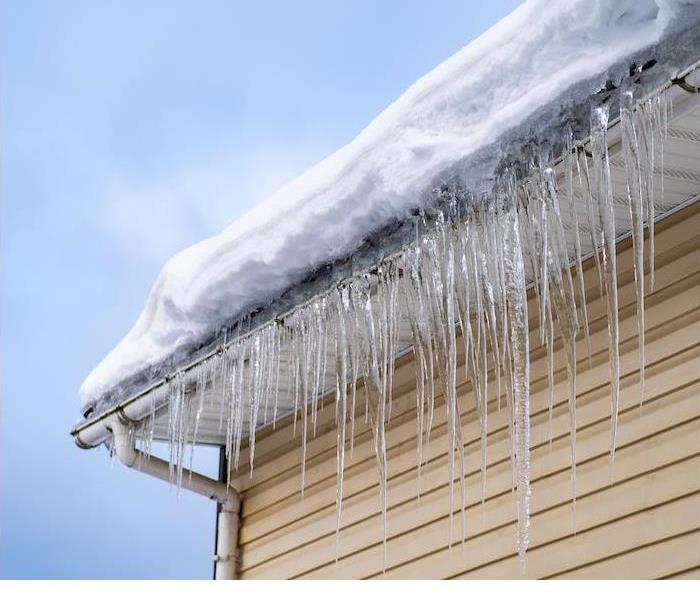 Prepare your San Diego home for winter by securing your roof, gutters, and windows against rain and wind.
Prepare your San Diego home for winter by securing your roof, gutters, and windows against rain and wind.
Winter in San Diego may not bring snowstorms or freezing temperatures, but it has its own set of challenges for homeowners. From heavy rain to unexpected gusty winds, the winter weather can still impact your home if you’re not prepared. Taking proactive steps can help you avoid costly repairs and maintain a safe, comfortable living space throughout the season.
##Protecting Your Home from Rain and Moisture
One of the most common winter weather issues in San Diego is heavy rain, which can lead to water damage if your home isn’t prepared. Begin by inspecting your roof for any loose or missing shingles, as these can allow water to seep through and cause leaks. Clean your gutters to ensure rainwater flows away from your home’s foundation rather than pooling around it.
Windows and doors are another critical area to check. Drafty seals or broken weather stripping can allow water to creep in and lead to mold growth. Properly sealing these openings not only protects against water damage but also improves your home’s energy efficiency, keeping you cozy during those cooler winter nights.
##Safeguard Against High Winds
While San Diego may not experience extreme windstorms, winter gusts can still cause damage. Ensure your trees are trimmed and healthy to avoid falling branches. Check outdoor furniture and décor to ensure they’re secure and won’t become hazardous projectiles during a storm.
If your home has a fence, give it a quick inspection to ensure it’s sturdy. Weak sections can be vulnerable to high winds, potentially causing property damage or safety hazards.
##Keep Your Home Ready for Winter
Even mild San Diego winters require preparation. Take the time to inspect your home now, and you’ll save yourself time, stress, and money down the road. For those moments when the unexpected happens, remember that SERVPRO of San Diego East is here to help®.
Whether it’s water damage from heavy rains or wind damage affecting your property, our expert team is just a call away.
When your home is impacted by winter weather, it’s essential to act quickly to minimize further damage. SERVPRO of San Diego East provides fast, reliable restoration services, giving you peace of mind when you need it most.
Ready to winter-proof your home or need assistance after a storm? Visit SERVPRO of San Diego East to learn more about our services and how we can help protect your home this winter.
Equipped and Ready: The Plan and Tools Your Business Needs to Be Fire Safe | SERVPRO of San Diego East
10/15/2024 (Permalink)
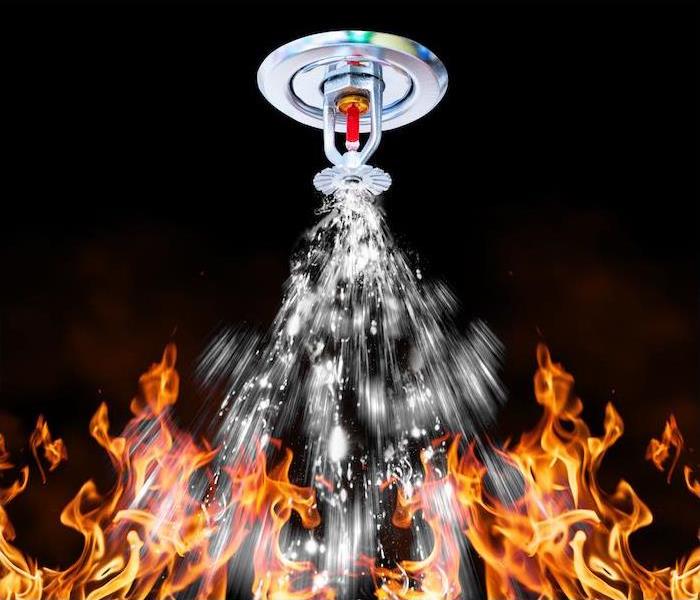 Protect your business with a safety plan! Contact SERVPRO® for expert guidance on fire prevention and ensure your employees and property stay safe.
Protect your business with a safety plan! Contact SERVPRO® for expert guidance on fire prevention and ensure your employees and property stay safe.
Running a business means juggling multiple responsibilities, and ensuring fire safety should always be a top priority. Fires can cause devastating losses, both financially and in terms of safety. In fact, according to recent statistics, businesses experience thousands of fires each year. For business owners in San Diego, Santee, Lake Murray, and our other neighborhoods, it’s crucial to have a solid fire prevention plan in place to protect your assets and employees.
Why Fire Safety Should Be a PriorityBusiness fire statistics show that fires most commonly occur during the hot, dry months of late summer and early fall in Southern California. During this time, the risk of fire is heightened due to higher temperatures, dry conditions, and, in some cases, faulty electrical equipment or overloaded circuits in older buildings.
A fire in your business can halt operations, damage equipment, and put your employees at risk. Having an effective fire safety plan in place not only helps reduce the risk but also ensures that everyone knows what to do in an emergency.
The Tools Your Business Needs for Fire PreventionTo minimize fire risks, every business owner should equip their property with essential fire prevention tools. Here’s a checklist to get you started:
- Smoke Detectors and Fire Alarms: Regularly check and maintain these devices to ensure they are working properly.
- Fire Extinguishers: Ensure they are placed in accessible areas and that employees are trained to use them.
- Sprinkler Systems: Regularly maintain your sprinkler system to ensure it will function properly in the event of a fire.
- Emergency Exits: Make sure all exits are clearly marked and accessible. Conduct fire drills so employees know where to go.
- Electrical Inspections: Periodic inspections by a licensed professional can help identify potential fire hazards, especially in older buildings.
Preparing Your Business with a Fire Safety PlanHaving the right tools is only one part of the equation. You also need a comprehensive fire safety plan to guide your team in case of an emergency. Create a fire evacuation plan and ensure every employee knows their role. Schedule regular fire drills to reinforce the plan and make adjustments as needed.
For businesses in our San Diego community, working with a professional can ensure your fire safety plan is both effective and up to date with local regulations. That’s where SERVPRO of San Diego East comes in.
At SERVPRO of San Diego East, we’re equipped to help you develop a fire prevention plan tailored to your business. Whether you need a risk assessment or guidance on maintaining fire safety equipment, we’re Here to Help®.
Contact us today to safeguard your business and employees with expert fire prevention solutions.
Visit our website at SERVPRO of San Diego East to learn more.
Stay Safe: Creating an Emergency Plan with Your Family | SERVPRO of San Diego East
10/2/2024 (Permalink)
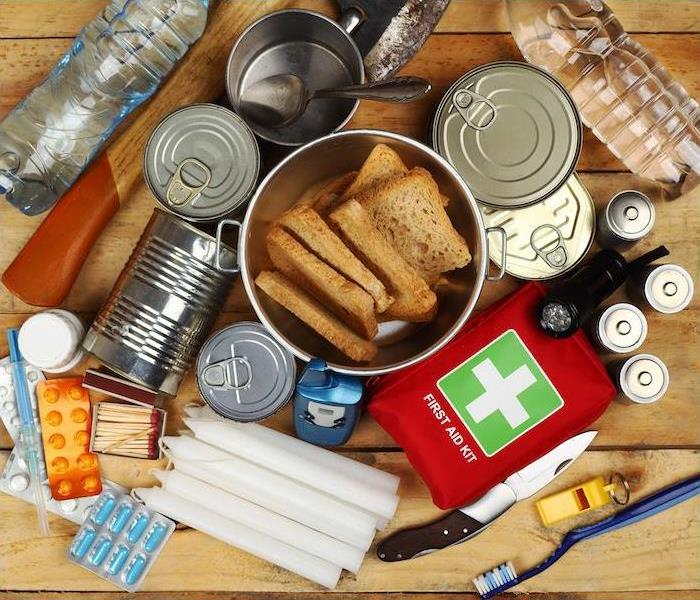 Use these helpful tips from SERVPRO of San Diego East to assemble an emergency kit to keep your family safe when disaster strikes.
Use these helpful tips from SERVPRO of San Diego East to assemble an emergency kit to keep your family safe when disaster strikes.
Natural disasters can strike without warning, and in the eastern part of San Diego, homeowners face several potential risks. From wildfires to earthquakes and flooding, having an emergency preparedness plan in place can help protect your home and family. In this blog, we’ll walk through the steps of creating a family emergency plan, so you’re ready to face any disaster that comes your way.
Why Emergency Preparedness is EssentialLiving in the San Diego area means being aware of the unique threats this area can face. Wildfires are a common risk during the dry summer and fall months. Flash flooding, though less frequent, can occur during periods of heavy rain in the winter, and earthquakes are a year-round possibility. Having a clear emergency plan ensures your family knows what to do and where to go when these disasters strike.
Steps to Create a Family Emergency Plan1. Identify Potential HazardsBegin by identifying the risks your home may face in your specific area. SERVPRO of San Diego East recommends focusing on the most common disasters such as wildfires, flooding, and earthquakes. Once you understand these hazards, you can better prepare your family and your home.
2. Establish a Communication PlanOne of the most critical aspects of emergency preparedness is ensuring that everyone knows how to communicate if you’re separated. Designate an out-of-town contact person and ensure all family members have their phone number saved. It’s also a good idea to have a local meeting spot where everyone can gather.
3. Create an Emergency KitHaving a well-stocked emergency kit is key. Fill it with essentials like water, non-perishable food, flashlights, first aid supplies, and necessary medications. Don’t forget important documents like insurance papers, passports, and IDs. SERVPRO of San Diego East recommends keeping the kit in an easily accessible place and checking it regularly to make sure nothing has expired.
Practice Makes PerfectAn emergency plan is only effective if your family is familiar with it. Hold regular family meetings to review and practice your plan. Go over evacuation routes, meeting points, and what each person’s role is during an emergency. Practicing can reduce confusion and anxiety when a real disaster occurs.
Keep SERVPRO of San Diego East in MindWhen disasters strike, having a plan in place can make all the difference. For professional disaster recovery services, SERVPRO of San Diego East is Here to Help®.
Prepare today, and rest easier knowing your family is ready to handle whatever comes your way!
Visit SERVPRO of San Diego East to learn more about how we can assist you before, during, and after a disaster.
Understanding Common Storms and How to Protect Your Home | SERVPRO of San Diego East
9/16/2024 (Permalink)
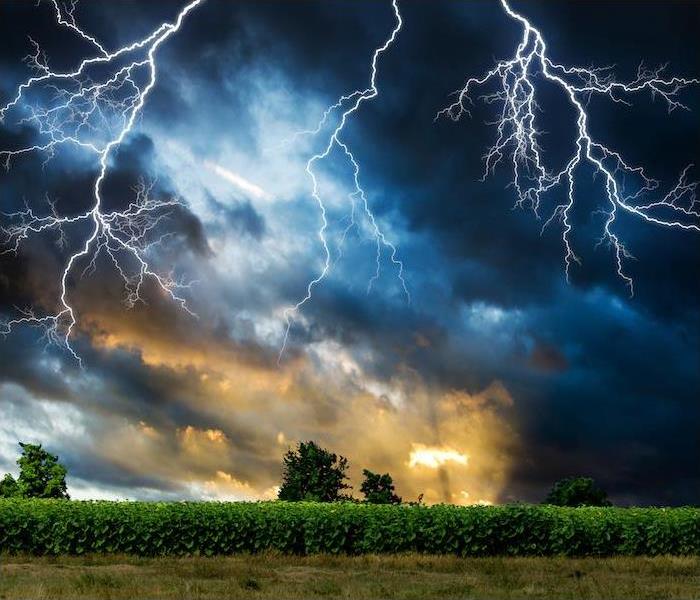 Don't delay! When storm damages affects your property, call SERVPRO of San Diego East to restore your space.
Don't delay! When storm damages affects your property, call SERVPRO of San Diego East to restore your space.
San Diego may be known for its beautiful weather, but that doesn’t mean it’s immune to severe storms. From heavy rain to strong winds, these storms can cause significant damage to your home if you’re not prepared. Understanding the types of weather events that can occur and knowing how to respond can save you a lot of headaches and costly repairs.
Types of Storms in San DiegoSan Diego’s unique coastal and desert climate means that homeowners need to be aware of a few different types of storms that can cause damage. One of the most common is heavy rain during the winter months. While San Diego doesn’t experience heavy rainfall as frequently as other areas, when it does occur, it can lead to flash flooding, especially in low-lying areas or places with poor drainage.
Another weather event that can impact San Diego homes is strong winds. These winds, particularly those from Santa Ana conditions, can knock down trees, damage roofs, and send debris flying, which can shatter windows or damage siding. Although less common, thunderstorms can also occur in San Diego, bringing lightning, hail, and even more intense winds.
How to Respond When Your Home is DamagedIf your home is damaged during one of these storms, it’s important to act quickly to prevent further issues. The first step is to assess the damage safely. Check your home for roof leaks, broken windows, or damaged siding, but be cautious of any potential hazards like downed power lines or flooding.
Once you have a sense of the damage, contact our professional restoration service experts at SERVPRO of San Diego East. Our team of experts can help you secure your home by covering broken windows or tarping over roof damage to prevent water from entering. We can also evaluate the extent of the damage and develop a plan for restoring your home to its pre-storm condition.
Time is critical in storm damage situations, as issues like water intrusion can lead to mold growth within just a few days. SERVPRO of San Diego East is available 24⁄7 to respond quickly and efficiently, minimizing the impact on your home and life.
Protect Your San Diego Home with SERVPRO of San Diego EastDon’t let storm damage catch you off guard. Understanding the risks and having a plan in place can make all the difference. If your home has been impacted by severe weather, trust the professionals at SERVPRO of San Diego East to restore it quickly and effectively.
Visit our website to learn more how we can help you protect your home.
How Gutters and Downspouts Protect Your Home or Business
9/12/2024 (Permalink)
In San Diego, CA, while we enjoy relatively mild weather, storms and heavy rains can still pose significant risks to homes and businesses. Gutters and downspouts play a crucial role in protecting your property from water damage. Here’s why they are essential and how they can help protect your property.
The Role of Gutters and Downspouts
Gutters and downspouts are designed to channel rainwater away from your building's foundation. This system helps prevent water from seeping into the foundation, causing structural damage, and flooding basements or crawl spaces. Properly maintained gutters and downspouts can make a significant difference in protecting your property.
Preventing Foundation Damage
One of the primary reasons gutters and downspouts are crucial is their role in protecting your foundation. When rainwater is not properly directed away from your home, it can pool around the foundation. Over time, this water can seep into the foundation, causing cracks and weakening the structure.
Avoiding Basement Flooding
Basements are particularly vulnerable to water damage if gutters and downspouts are not functioning correctly. Water that pools around the foundation can easily find its way into basements, leading to flooding. This can cause significant damage to personal belongings, HVAC systems, and even create a breeding ground for mold. According to FEMA, even a few inches of water can cause tens of thousands of dollars in damage.
Protecting Landscaping
Properly functioning gutters and downspouts also protect your landscaping. Without them, rainwater can cause soil erosion, wash away plants, and damage flower beds. By directing water away from your property, you can maintain the integrity and beauty of your landscape.
Preventing Mold and Mildew
Mold and mildew thrive in damp environments. Water that leaks into your home due to faulty gutters and downspouts can create ideal conditions for mold growth. Proper drainage helps keep your home dry and reduces the risk of mold-related issues.
Maintenance Tips for Gutters and Downspouts
To ensure your gutters and downspouts are working effectively, regular maintenance is necessary.
Regular Cleaning
Cleaning your gutters at least twice a year is essential to remove leaves, twigs, and other debris that can cause blockages. Clogged gutters can overflow, leading to the very issues they are meant to prevent. During the fall and spring, check your gutters and remove any debris to keep them clear.
Inspect for Damage
Regularly inspect your gutters and downspouts for signs of damage. Look for cracks, rust, or areas where they are pulling away from the house. Addressing these issues promptly can prevent more significant problems down the line.
Ensure Proper Installation
Proper installation is key to the effectiveness of gutters and downspouts. Ensure that they are pitched correctly to allow water to flow toward the downspouts and that the downspouts direct water at least three feet away from the foundation.
Consider Gutter Guards
Gutter guards can be a valuable addition to your gutter system. They help prevent debris from entering the gutters while allowing water to flow through freely. This can reduce the frequency of cleaning and help maintain proper function.
Protect Your Property with Gutter Maintenance
Gutters and downspouts are essential against water damage. Regular maintenance and professional assistance are key to ensuring your gutters and downspouts perform optimally. If your home or business suffers from storm damage, don’t hesitate to contact our SERVPRO of San Diego East team today! We are here to help you keep your property safe and secure from storm damage.
Understanding Fall Fire Risks and Keeping Your Home Safe | SERVPRO of San Diego East
9/6/2024 (Permalink)
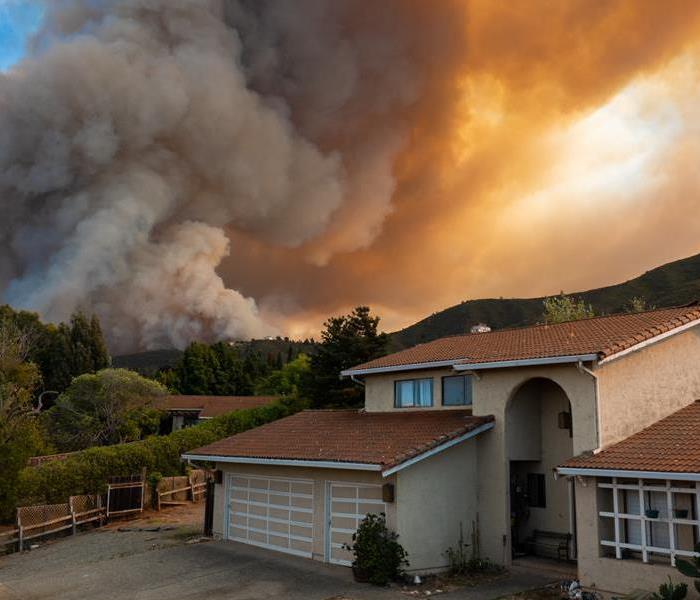 sky with dark smoke and flames as it burns close to a house
sky with dark smoke and flames as it burns close to a house
As the crisp fall air settles in, it's easy to forget that the risk of wildfires remains high all around San Diego. The combination of dry conditions and seasonal winds can turn a small spark into a devastating blaze. Protecting your home during these months is crucial, and SERVPRO of San Diego East is Here to Help® you understand the fire risks and how to safeguard your property.
Why Fall and Winter Bring Fire Risks
In the eastern communities of San Diego, the fall and winter months are often associated with the Santa Ana winds, which are known for their hot, dry gusts. These winds can rapidly spread wildfires, making it a dangerous time for homeowners. Additionally, the dry vegetation from the summer heat provides ample fuel for any fire that starts. The risk doesn't diminish just because temperatures drop—in fact, it can increase as people use more heaters and fireplaces, which can also spark accidental fires.
Protecting Your Home from Wildfire Threats
Taking proactive steps can significantly reduce the risk of fire damage to your home. Here are some essential tips:
- Create Defensible Space: Clear any dead or dry vegetation from around your home. Maintain a defensible space of at least 30 feet where possible, ensuring that trees, shrubs, and other plants are well-maintained and away from structures.
- Roof and Gutter Maintenance: Dry leaves and debris can easily catch fire, especially when the Santa Ana winds pick up. Regularly clean your roof and gutters to prevent this hazard.
- Fire-Resistant Landscaping: Consider using fire-resistant plants and materials in your landscaping. These can help slow the spread of fire and give firefighters more time to protect your home.
- Inspect and Maintain Heating Equipment: As you begin using fireplaces, wood stoves, and space heaters more frequently, ensure they are in good working order and that you follow all safety guidelines.
- Install Fire-Resistant Vents: Embers can enter your home through vents. Installing fire-resistant vents can help keep these embers out and reduce the risk of your home catching fire.
SERVPRO of San Diego East: Your Partner in Fire Safety
At SERVPRO of San Diego East, we understand the unique fire risks that come with living in Southern California. Our team is Here to Help® you protect your home and recover quickly if the worst should happen. By taking the proper precautions and staying informed, you can reduce the chances of fire damage and keep your family safe.
If you need help with fire prevention or restoration services, don’t hesitate to reach out. Let’s work together to keep your home safe this fall and winter!
Visit our website at SERVPRO of San Diego East to learn more and get the support you need.
How to Choose the Right Fire Restoration Company
8/14/2024 (Permalink)
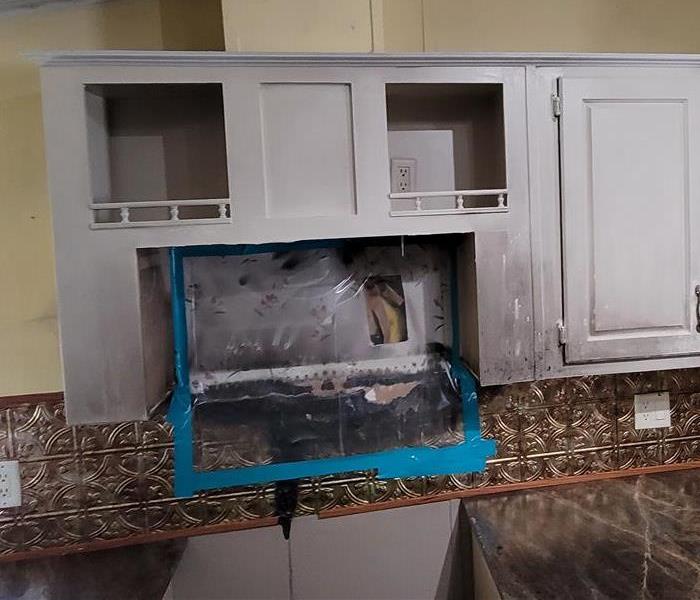 Fire damage restoration is time-sensitive. The longer the damage sits, the worse it can get.
Fire damage restoration is time-sensitive. The longer the damage sits, the worse it can get.
Experiencing a fire in your home or business is incredibly stressful and scary. The aftermath can be overwhelming, but choosing the right fire restoration company can make the recovery process smoother and more effective. If you’re in San Diego, CA, and need fire restoration services, here are some tips to help you select a reputable company.
1. Look for Certified Professionals
Certifications Matter
A reputable fire restoration company will have certified professionals. Look for certifications from recognized organizations such as the Institute of Inspection, Cleaning and Restoration Certification (IICRC). This certification ensures that the company adheres to industry standards and uses the latest techniques in fire damage restoration.
Experience and Training
Experience is crucial. Companies with a long history in the industry have likely encountered various fire damage scenarios and have the expertise to handle complex situations. Additionally, ensure that the staff undergoes regular training to stay updated on the latest restoration methods and safety protocols.
2. Comprehensive Services
Range of Services
Fire damage goes beyond just burnt structures. A reputable company should offer comprehensive services, including smoke and soot removal, odor control, structural repair, and water damage restoration from firefighting efforts. This ensures that all aspects of fire damage are addressed.
Advanced Equipment
The right company will use advanced equipment and techniques to restore your property efficiently. This includes industrial-grade dehumidifiers, air movers, thermal foggers, and ozone machines for odor removal.
3. Check Reviews and References
Online Reviews
Look for companies with positive reviews on platforms like Google, Yelp, and the Better Business Bureau (BBB). Consistently high ratings and detailed customer feedback can provide insight into the company’s reliability and quality of work.
Ask for References
Don’t hesitate to ask the company for references from past clients. Speaking directly with previous customers can give you a clearer picture of what to expect and confirm the company’s reputation.
4. Response Time and Availability
24/7 Emergency Services
Fire damage restoration is time-sensitive. The longer the damage sits, the worse it can get. Choose a company that offers 24/7 emergency services and can respond quickly to minimize further damage and start the restoration process as soon as possible.
Local Presence
A local company in San Diego, CA, can respond faster than one that is located further away. Local companies are also more familiar with the area’s specific regulations and climate-related issues that might affect the restoration process.
5. Insurance and Licensing
Proper Licensing
Ensure the company is properly licensed to operate in San Diego, CA. This guarantees they meet local regulations and standards for fire restoration work.
Insurance Assistance
Navigating insurance claims can be daunting after a fire. A reputable restoration company will assist you with the insurance process, providing detailed documentation and working directly with your insurance adjuster to ensure your claim is handled smoothly.
6. Personalized Service
Detailed Assessment
A reputable company will provide a thorough assessment of the damage and a detailed plan for restoration. They should explain the process clearly, so you know what to expect every step of the way.
Customer Service
Excellent customer service is a hallmark of a reputable company. They should be responsive to your questions and concerns, and treat your property with respect and care.
Making the Right Choice
Choosing the right fire restoration company is crucial for effective recovery after a fire. In San Diego, CA, look for certified professionals, comprehensive services, positive reviews, and a quick response time. Ensure they are licensed, offer insurance assistance, and provide personalized service. By following these tips, you can find a reliable company like SERVPRO of San Diego East that will help you restore your property and peace of mind efficiently and effectively.
8 Tips to Prevent Mold in Your Vacation Rental
7/17/2024 (Permalink)
 Our SERVPRO of San Diego East team can provide detailed advice and services to keep your property in excellent condition.
Our SERVPRO of San Diego East team can provide detailed advice and services to keep your property in excellent condition.
As a vacation rental owner, maintaining a mold-free property is essential for ensuring guest satisfaction and protecting your investment. Mold can quickly turn a guest’s dream vacation into a nightmare and result in negative reviews, which can hurt your rental business. Here’s how you can protect your vacation rental from mold with some effective strategies.
Keeping Your Vacation Rental Mold-Free
- Regular Inspections
Make it a routine to inspect your property for signs of mold and moisture, especially before and after the property is occupied. Check common problem areas like bathrooms, kitchens, and any places with plumbing. Look for water stains, leaks, or condensation issues, which are precursors to mold growth.
- Enhance Air Circulation
Proper ventilation is crucial in preventing mold. Ensure that your property has adequate airflow. Use ceiling fans, exhaust fans, and occasionally open windows to help reduce moisture. Encourage guests to use bathroom and kitchen fans regularly to keep air moving.
- Control Humidity
Invest in a good-quality dehumidifier to help maintain the humidity levels below 60%, which is recommended to hinder mold growth. In humid climates, this can be especially important in preventing the damp conditions in which mold thrives.
- Quick Response to Water Problems
Any spills, leaks, or flooding should be addressed immediately to prevent the moisture from seeping into floors, walls, and furniture. Make sure your guests know how to contact maintenance quickly in case of such issues.
- Use Mold-Resistant Products
When updating or repairing your rental, choose mold-resistant materials such as paints, drywall, and fabrics. These products can be particularly effective in high-moisture areas like bathrooms and kitchens.
- Keep It Clean
Regular and thorough cleaning can help prevent mold growth. Ensure that bathrooms and kitchens are kept dry and well-ventilated. Provide guests with cleaning supplies and encourage them to wipe down surfaces where moisture may accumulate.
- Maintain Gutters and Drainage
Ensure that your property’s gutters are clean and free from debris to prevent water buildup. Proper exterior drainage is also crucial to steer water away from the foundation, which can be a significant factor in preventing mold.
- Educate Your Guests
Include information in your welcome book about the importance of preventing mold, such as using exhaust fans and managing humidity. Simple guidelines can empower guests to help maintain the property during their stay.
Protecting your vacation rental from mold is crucial for the longevity of your property and the satisfaction of your guests. Regular inspections, proper humidity control, and good cleaning practices are key strategies to prevent mold. By taking these proactive steps, you can ensure that your property remains a top choice for vacationers looking for a comfortable and healthy place to stay.
For more information on mold prevention and maintenance for vacation rentals, consider consulting with mold remediation professionals, such as our SERVPRO of San Diego East team, who can provide more detailed advice and services to keep your property in excellent condition.
Flood Damage vs. Water Damage: Key Differences
6/12/2024 (Permalink)
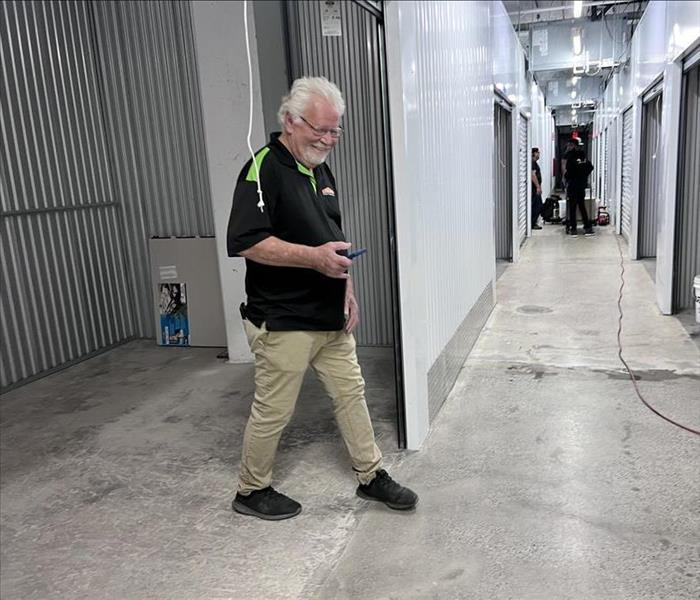 Our team is knowledgeable in the key differences between flood damage and water damage.
Our team is knowledgeable in the key differences between flood damage and water damage.
Water damage is a common issue that homeowners may encounter, whether caused by a burst pipe, leaky roof, or plumbing malfunction. However, when it comes to the extent and severity of damage, there are distinct differences between water damage and flood damage. Understanding these differences is crucial for taking the appropriate actions and seeking professional assistance. In this blog, we will discuss the key differences between flood damage and water damage.
Causes of Damage
One of the primary distinctions between flood damage and water damage lies in their causes. Water damage typically arises from internal sources within the home, such as faulty appliances, burst pipes, or damaged roofs. These incidents are often localized and can affect specific areas or rooms within the property.
On the other hand, flood damage occurs as a result of external water sources, such as heavy rain, rising rivers, or coastal storm surge. Floodwater can infiltrate various parts of the property, affecting multiple rooms or even the entire structure.
Severity and Volume
Flood damage is generally more severe and extensive compared to typical water damage incidents. Floodwater is often widespread, covering large areas and affecting multiple levels of a property. The volume and pressure of floodwater can cause significant damage to walls, foundations, flooring, and other structural elements.
Water damage, while still significant, is usually contained within a specific area or room. The volume of water involved may be smaller, but it can still lead to significant damage if not addressed promptly. However, water damage from sources like burst pipes or malfunctioning appliances can quickly escalate if left unresolved.
Types of Water
The type of water involved in the damage is another critical distinction. Floodwater is classified as Category 3 or black water, which is highly contaminated and poses potential health risks. It can contain sewage, chemicals, debris, and other hazardous substances. Due to its unsanitary nature, professional remediation and proper precautions are necessary when dealing with flood damage.
Water damage from internal sources is typically Category 1 or clean water, which poses minimal health risks. Clean water may come from a broken supply line, faucet, or other freshwater sources. However, if left untreated or unresolved, clean water can become contaminated and escalate to higher categories, requiring more extensive remediation.
Insurance Coverage
Insurance coverage is often another differentiating factor between flood damage and water damage. While standard homeowners' insurance policies usually cover water damage from internal sources, such as burst pipes or plumbing leaks, they may not provide coverage for flood damage.
Flood damage is typically covered under a separate flood insurance policy that homeowners can purchase through the National Flood Insurance Program (NFIP) or private insurers. It's essential for homeowners in flood-prone areas to have flood insurance in place to protect their property from flood-related damages.
Understanding the differences between flood damage and water damage is crucial for homeowners to take appropriate actions and seek professional assistance promptly. Whether dealing with flood damage or water damage, it is essential to engage certified restoration professionals like SERVPRO® for efficient and thorough remediation. If you require assistance with flood or water damage restoration, contact SERVPRO for expert and reliable restoration services tailored to your specific needs.
Safeguarding Your Valuables from Storm Damage
5/15/2024 (Permalink)
Storms can wreak havoc on your home, causing significant damage to your property and belongings. While it's essential to prepare your home for storms and take preventive measures, safeguarding your valuables is equally important. In this blog, we'll explore effective ways to protect your valuables from storm damage, ensuring that your most prized possessions remain safe and secure.
Create a Home Inventory
Before a storm strikes, it's crucial to create a detailed home inventory of all your valuables. This inventory should include items such as jewelry, important documents, electronics, artwork, and sentimental items. Documenting your possessions will not only help you assess potential damage post-storm but also assist you in filing insurance claims if needed.
Consider taking photographs or videos of your valuables and storing them in a safe place or digitally in the cloud. Having a comprehensive inventory will enable you to account for all your belongings and streamline the restoration process in case of storm damage.
Invest in Waterproof Containers
Water damage is a common consequence of storms, particularly flooding. To protect your valuables from water damage, invest in waterproof containers or safes. Store important documents, jewelry, and other valuables in these containers to shield them from water infiltration during a storm.
Place the containers in elevated areas of your home to minimize the risk of water exposure. Additionally, consider storing digital copies of important documents on a secure external hard drive or a cloud storage platform for added protection.
Secure Valuables in a Safe
For valuable items such as jewelry, cash, and important documents, consider storing them in a fireproof and waterproof safe. Safes offer an additional layer of protection against storm damage, theft, and fire hazards. Opt for a safe with a high fire and water resistance rating to ensure maximum protection for your valuables.
Place the safe in a secure and easily accessible location within your home, such as a closet or basement. Remember to regularly update the contents of the safe and maintain the safe's security features for enhanced protection.
Utilize Shelving and Storage Solutions
Organizing and storing your valuables on high shelves or elevated platforms can prevent water damage during a storm. Utilize sturdy shelves, cabinets, or storage solutions to keep your valuables off the ground and out of harm's way.
Install shelving units in your home office, garage, or storage areas to store items such as electronics, collectibles, and sentimental objects. By elevating your valuables, you reduce the risk of water exposure and potential damage during a storm.
Consider Off-Site Storage
In preparation for severe storms, consider storing your valuables in an off-site storage facility. Renting a storage unit or utilizing a safe deposit box at a bank can safeguard your valuables from home damage caused by storms.
Transfer items of high value, sentimental significance, or irreplaceable nature to an off-site location for safekeeping. Ensure that the storage facility is secure, climate-controlled, and equipped to protect your belongings from storm damage.
Conclusion
Protecting your valuables from storm damage is essential in safeguarding your most cherished possessions and assets. By creating a home inventory, investing in waterproof containers, securing valuables in a safe, utilizing shelving solutions, and considering off-site storage options, you can mitigate the risk of damage during a storm.
In the unfortunate event of storm damage, contact SERVPRO® for professional storm damage recovery and restoration services. Our experienced team is equipped to handle the restoration of your home and belongings with efficiency and care, ensuring that your property is restored to its pre-storm condition.
Prioritize the protection of your valuables and take proactive measures to safeguard them from storm damage. By implementing these strategies, you can minimize the impact of storms on your most treasured possessions and maintain peace of mind during inclement weather.
The benefits of installing fire-rated doors and windows
4/9/2024 (Permalink)
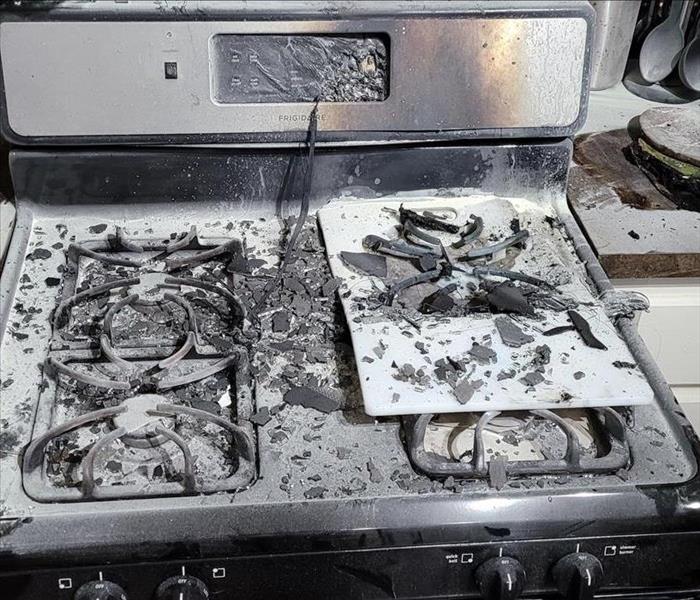 Prevent fire disasters with some preparedness before disaster strikes.
Prevent fire disasters with some preparedness before disaster strikes.
As a trusted leader in the restoration and cleanup industry, SERVPRO® is committed to not only responding to disasters but also preventing them. In this blog post, we're going to shed light on a crucial aspect of fire safety—installing fire-rated doors and windows. Understanding the benefits of these installations can be a game-changer for both residential and commercial properties.
Containment of Fire Spread
Fire-rated doors and windows play a pivotal role in containing the spread of flames. In the unfortunate event of a fire, these specialized structures act as barriers, preventing the fire from rapidly advancing through a building. This containment can significantly minimize property damage and enhance the safety of occupants.
Increased Escape Time
Time is of the essence during a fire emergency. Fire-rated doors and windows provide occupants with precious additional minutes to evacuate safely. This added escape time can be the difference between a successful evacuation and potential injuries.
Protection of Valuables
Beyond personal safety, fire-rated doors and windows safeguard valuable assets and critical documents within a property. By impeding the fire's progress, these installations give firefighters more time to respond effectively, potentially saving both property and irreplaceable items.
Compliance with Building Codes
Installing fire-rated doors and windows ensures compliance with local building codes and regulations. Authorities often require these safety features, and meeting such standards not only keeps occupants safe but also prevents legal complications for property owners.
Insurance Premium Reductions
Property owners who prioritize safety by installing fire-rated doors and windows may enjoy reduced insurance premiums. Insurers recognize the added protection these features provide, leading to potential cost savings over the long term.
Enhanced Property Value
Safety features, such as fire-rated doors and windows, contribute to the overall value of a property. Prospective buyers or tenants often prioritize safety when considering a place to live or conduct business. Investing in these measures can make your property more attractive in the market.
Peace of Mind for Occupants
Perhaps the most significant benefit of all is the peace of mind that fire-rated doors and windows bring to occupants. Knowing that their safety is prioritized provides a sense of security, fostering a more positive living or working environment.
The installation of fire-rated doors and windows is a proactive step toward mitigating the devastating effects of a fire. At SERVPRO, we encourage property owners to prioritize safety and take preventive measures. For more information on fire safety and disaster preparedness, feel free to reach out to our experts. Your safety is our priority, from prevention to restoration.
Everything You Need to Know About Bathroom Mold: Causes, Prevention, and Removal
3/13/2024 (Permalink)
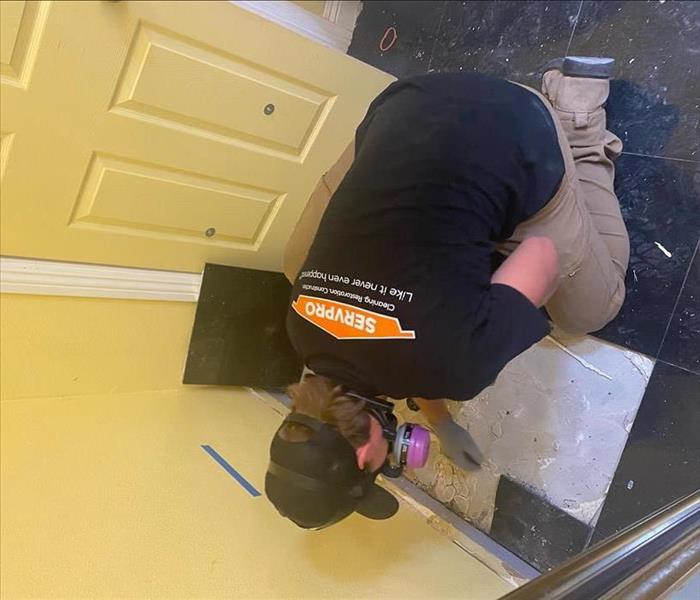 In this blog, we will explore the causes, prevention, and removal of mold in the bathroom.
In this blog, we will explore the causes, prevention, and removal of mold in the bathroom.
Mold growth in the bathroom is a common problem due to the high moisture levels found in this area. Not only is bathroom mold unsightly, but it can also deteriorate surfaces and cause potential health risks. Understanding the causes of bathroom mold, implementing preventive measures, and knowing how to effectively remove it is essential for maintaining a clean and healthy bathroom environment. In this blog, we will explore the causes, prevention, and removal of mold in the bathroom.
Causes of Mold in the Bathroom
Excess Moisture: Bathrooms are prone to excess moisture due to activities like showering, bathing, and washing. This moisture, along with the lack of ventilation, creates an ideal breeding ground for mold spores to grow and thrive.
Poor Ventilation: Inadequate ventilation can lead to moisture buildup, encouraging mold growth. Bathrooms with no or insufficient windows, exhaust fans, or proper airflow can trap moisture and promote the development of mold.
Leakages: Leaking pipes, faucets, and fixtures contribute to excess moisture in the bathroom. These hidden sources can go unnoticed for an extended period, creating the perfect environment for mold to flourish.
Prevention of Mold in the Bathroom
Proper Ventilation: Install an exhaust fan or use a window to facilitate air circulation and remove excess moisture from the bathroom. Ensure the fan is appropriately sized for the room and vented to the outside to prevent mold spores from circulating back into the bathroom.
Regular Cleaning: Regularly clean and dry bathroom surfaces to prevent mold growth. Wipe down wet surfaces such as shower walls, tubs, and sinks after each use. Use a squeegee or towel to remove excess moisture and discourage mold growth.
Fix Leaks: Promptly repair any leaks or water damage in pipes, faucets, or fixtures to prevent moisture accumulation. Regularly inspect and maintain plumbing systems to avoid potential mold problems.
Reduce Humidity: Use a dehumidifier or open windows to reduce humidity levels in the bathroom. Lowering humidity discourages mold growth and promotes a healthier bathroom environment.
Removal of Mold from the Bathroom
Safety Precautions: Before starting the mold removal process, take necessary safety precautions, such as wearing gloves, goggles, and a mask to prevent exposure to mold spores. Ensure the area is well-ventilated to minimize inhalation of mold particles.
Cleaning Products: Use mold cleaning products that are specifically designed for bathroom mold remediation. Look for products that contain ingredients such as sodium hypochlorite or hydrogen peroxide, which are effective in killing mold spores. Follow the instructions on the product for proper use and safety.
Scrubbing and Drying: Scrub the moldy area with a brush or sponge and the mold cleaning product. Thoroughly rinse the area and ensure it is completely dry. Drying the area prevents further mold growth and reduces the chances of moisture-related issues.
Professional Mold Remediation: When dealing with extensive or persistent mold growth, it is advisable to seek professional mold remediation services. Trained professionals, like SERVPRO®, can accurately assess the extent of mold damage, ensure proper removal, and address the underlying causes to prevent future mold recurrence.
Preventing and removing mold in the bathroom is vital for maintaining a clean and healthy environment. By addressing the causes of bathroom mold, implementing preventive measures, and using appropriate cleaning products, you can effectively control mold growth. Regular cleaning, proper ventilation, and prompt repair of leaks are key preventive strategies. If mold growth persists or becomes extensive, it is best to consult professionals to ensure thorough and safe mold remediation.
Everything You Need to Know About Drying Equipment
2/20/2024 (Permalink)
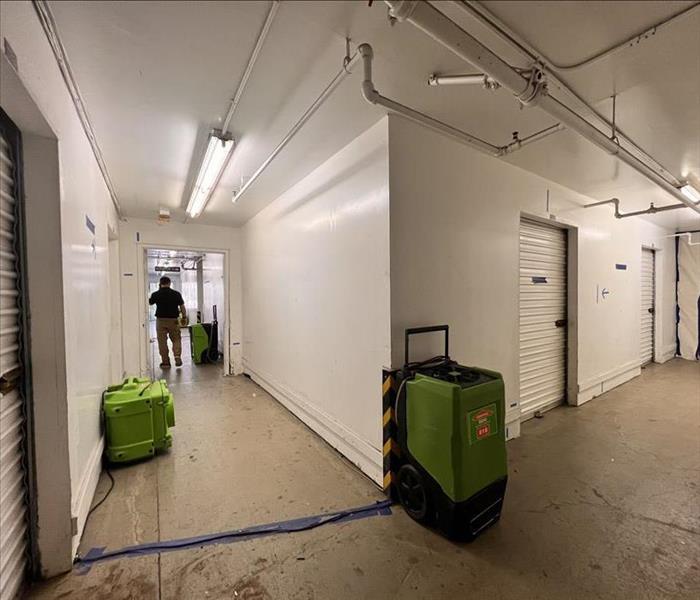 The success of drying techniques lies in the balance of various tools and methods.
The success of drying techniques lies in the balance of various tools and methods.
Water damage can be a homeowner's nightmare, but fear not – efficient drying techniques are the unsung heroes in the battle against water leaks. Let's demystify the workings of essential drying equipment such as air movers and dehumidifiers.
1. Air Movers: The Powerhouse of Evaporation
Air movers, often resembling high-powered fans, play a crucial role in accelerating the evaporation process. By creating a continuous flow of air across wet surfaces, they enhance moisture evaporation, turning water into water vapor. This swift evaporation is essential in preventing stagnant water, minimizing the risk of mold growth, and expediting the overall drying process.
2. Dehumidifiers: Moisture's Nemesis
Dehumidifiers are the heavy lifters in the drying arsenal. These machines work by extracting excess moisture from the air, reducing humidity levels to an optimal range. The process involves pulling in moist air, cooling it to condense the moisture into water, and then releasing the drier air back into the environment. This not only assists in drying surfaces but also prevents secondary issues like mold and mildew.
3. Moisture Meters: Precision in Progress
Precision is crucial in the drying game, and moisture meters are the tools that provide it. These handheld devices measure the moisture content of various materials, helping professionals assess the effectiveness of drying techniques. By pinpointing areas with lingering moisture, technicians can tailor their approach, ensuring a thorough drying process.
4. Desiccants: Absorbing Moisture Like a Sponge
Desiccant dehumidifiers are like moisture-absorbing sponges. These units use a desiccant material, typically silica gel, to absorb moisture from the air. As the desiccant attracts and holds the water vapor, the air becomes drier. Desiccants are especially effective in extremely humid conditions and are often employed in specialized drying situations.
5. Injection Drying: Targeted Precision
Injection drying is a precision technique that involves directing drying air into specific spaces within walls, ceilings, or floors. By creating openings and strategically placing air movers, technicians can target hard-to-reach areas that might be holding onto moisture. This method ensures a more thorough drying process.
In conclusion, the success of drying techniques lies in the balance of various tools and methods. Air movers accelerate evaporation, dehumidifiers wring excess moisture from the air, moisture meters provide precision, desiccants absorb like sponges, and injection drying reaches hidden corners. When orchestrated effectively, these techniques transform a water damage nightmare into a successfully dried and restored space.
Understanding Winter Storms in San Diego
1/14/2024 (Permalink)
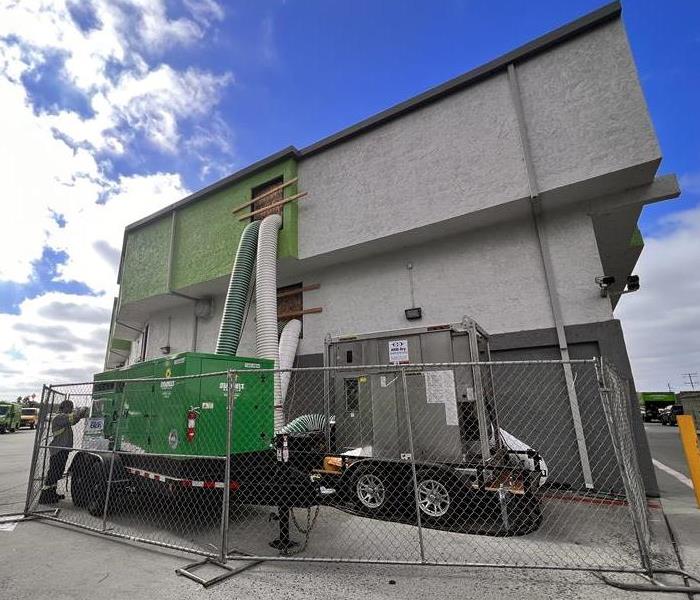 SERVPRO of San Diego East stands ready to assist our fellow San Diego residents in post-storm recovery efforts.
SERVPRO of San Diego East stands ready to assist our fellow San Diego residents in post-storm recovery efforts.
San Diego's reputation for sunny days doesn't shield it from occasional winter storms that can bring unexpected challenges. Understanding these weather phenomena is crucial for preparedness. In this blog, we'll explore the dynamics of winter storms in San Diego and offer insights and tips to navigate these weather events effectively.
Winter Storm Dynamics in San Diego
San Diego experiences distinct characteristics during winter storms, often marked by heavy rainfall. These storms can lead to potential flooding in low-lying areas and increase the risk of flash floods in some neighborhoods due to rapid rainwater accumulation. Strong winds are another hallmark, occasionally causing damage to structures, trees, and power lines. Additionally, hilly or mountainous areas may face a heightened risk of landslides as the soil becomes saturated with rainfall.
Preparation and Safety Measures
Preparing for these winter storms in San Diego requires a proactive approach. Creating an emergency preparedness checklist tailored to the region is essential. This includes securing outdoor items, establishing evacuation plans, reviewing insurance policies, and ensuring readiness with emergency kits. Protecting homes against potential storm damage is critical. Inspecting roofs, clearing gutters, securing windows, and fortifying doors are advisable precautions.
Flood Prevention and Mitigation
Due to the risk of flooding in certain areas, flood prevention measures become crucial. Deploying sandbags, maintaining drainage systems, and securing flood insurance are recommended steps to minimize potential damage. Staying indoors during storms, avoiding floodwaters, staying updated on weather alerts, and having an emergency kit ready are crucial safety practices for residents.
SERVPRO's Role in Post-Storm Recovery
SERVPRO of San Diego East stands ready to assist our fellow San Diego residents in post-storm recovery efforts. With specialized expertise in storm damage restoration, water extraction, mold remediation, and property restoration, our team is equipped to address storm-related challenges promptly and efficiently. We offer local knowledge and a swift response to aid in restoring properties and ensuring a smoother recovery process.
Understanding the dynamics of winter storms in San Diego empowers residents to take proactive measures to protect themselves and their properties. By staying informed, prepared, and vigilant, residents can mitigate risks and ensure safety during inclement weather conditions.
Protecting Your Home: 10 Tips to Prevent Candle Fires
12/20/2023 (Permalink)
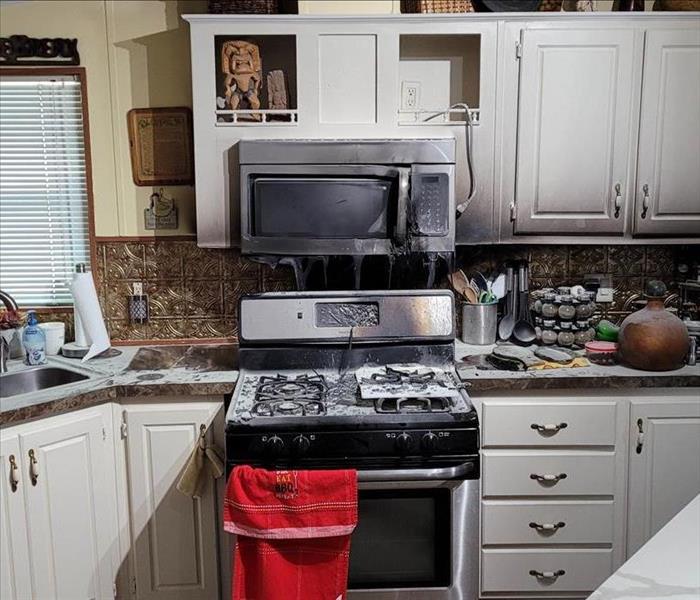 By following these 10 tips, you can enjoy the cozy glow of candles without putting your home at risk of a fire.
By following these 10 tips, you can enjoy the cozy glow of candles without putting your home at risk of a fire.
Your safety is a top priority, and today we're here to discuss a common household hazard - candle fires. Candles can create a warm and inviting atmosphere in your home, but if not handled with care, they can also pose a significant fire risk. In this blog, we'll provide you with essential tips to prevent candle fires and keep your home safe.
- Choose Safe Candle Types
Opt for flameless LED candles, which can provide a realistic glow without the risk of an open flame. They are a safe and energy-efficient alternative to traditional candles.
- Keep Candles Away from Flammable Materials
Place candles at least 12 inches away from anything that can catch fire, such as curtains, tablecloths, and paper products.
- Use Proper Candle Holders
Select sturdy, non-combustible candle holders to secure your candles. Make sure they are the appropriate size for the candle and won't tip over.
- Trim Wick Length
Trim candle wicks to about 1/4 inch to prevent excessive smoke and uneven burning. A long, unruly wick can lead to a larger flame and an increased risk of fire.
- Never Leave Candles Unattended
Always extinguish candles before leaving a room or going to bed. Consider using a timer to ensure they are not left burning.
- Place Candles on Stable Surfaces
Keep candles on a stable, flat surface, away from drafts that can cause them to flicker or tip over.
- Create a "No-Candle Zone"
Keep candles out of reach of children and pets. Educate your family about the dangers of open flames and establish a "no-candle zone" where children should not enter.
- Avoid Overcrowding
Do not place too many candles in a small area. Overcrowding can increase the risk of accidents, especially when moving around.
- Be Mindful of Candle Placement
Avoid placing candles in high-traffic areas or where they can be easily knocked over. This is especially important in homes with young children or pets.
- Install Smoke Detectors
Ensure you have working smoke detectors in your home, especially near areas where you use candles. Regularly check and change the batteries to keep them operational.
Candles can add a touch of ambiance to your home, but safety should always come first. By following these 10 tips, you can enjoy the cozy glow of candles without putting your home at risk of a fire. Remember, prevention is key, but in the event of a fire emergency, contact SERVPRO® of San Diego East for professional fire damage restoration services. Stay safe, and protect your home and loved ones from the threat of candle fires.
How to Get Rid of Mold Smell in Your Home
11/14/2023 (Permalink)
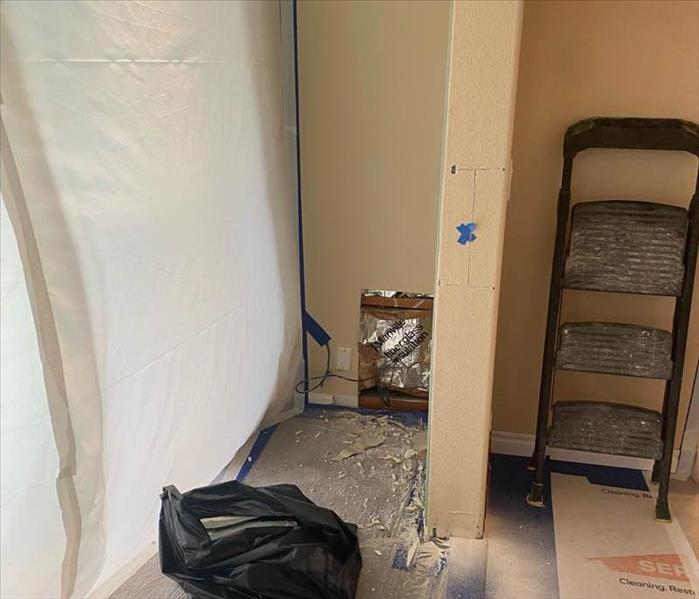 One common issue that can impact your living space is the unpleasant mold smell.
One common issue that can impact your living space is the unpleasant mold smell.
San Diego homeowners take pride in their properties, and maintaining a fresh, clean home is essential. One common issue that can impact your living space is the unpleasant mold smell. In this blog, we'll explore effective ways to eliminate that moldy odor from your home and ensure it stays fresh and inviting.
Identifying the Mold Smell
Mold odor can be quite distinctive and is often described as musty, damp, or earthy. If you notice this odor in your home, here's what you need to do:
- Locate the Source: Start by identifying areas in your home where the smell is most pronounced. Common culprits include damp basements, bathrooms, or areas that have experienced water damage.
- Inspect for Visible Mold: Check for visible mold growth on surfaces like walls, ceilings, or even hidden areas like crawlspaces and attics. Mold may be the source of the odor.
Effective Ways to Eliminate Mold Smell
To get rid of the mold smell, follow these steps:
- Ventilation: Proper ventilation is crucial in preventing and reducing mold odors. Open windows and use fans to increase air circulation in your home. Fresh air can help dissipate the musty smell.
- Remove the Source: If you find mold growth, it's important to address it at its source. Clean and remove the mold using appropriate cleaning agents. If the issue is extensive, consider professional mold remediation.
- Dehumidify: Mold thrives in high humidity conditions. Use a dehumidifier to maintain indoor humidity levels between 30-50%. This will discourage mold growth and help eliminate the odor.
- Baking Soda: Place bowls of baking soda in areas with mold smell. Baking soda acts as a natural deodorizer and can absorb odors effectively.
- Activated Charcoal: Activated charcoal is another excellent odor absorber. You can place charcoal pouches or containers in the affected areas.
- Air Purifiers: Consider using air purifiers with HEPA filters to remove airborne particles, including mold spores, and improve indoor air quality.
- Professional Help: If the mold odor persists despite your efforts, it may be time to consult professionals like SERVPRO® of San Diego East for comprehensive odor removal and mold remediation services.
Getting rid of the mold smell in your San Diego home is essential for a pleasant living environment. By following these tips, you can effectively eliminate mold odors and prevent their return. Remember that timely action and proper maintenance are key to ensuring your home always smells fresh and inviting. If you require expert assistance in addressing mold issues or persistent odors, don't hesitate to contact our SERVPRO® team for professional solutions and peace of mind.
5 Steps to Protect Your San Diego Home from Water Damage
10/10/2023 (Permalink)
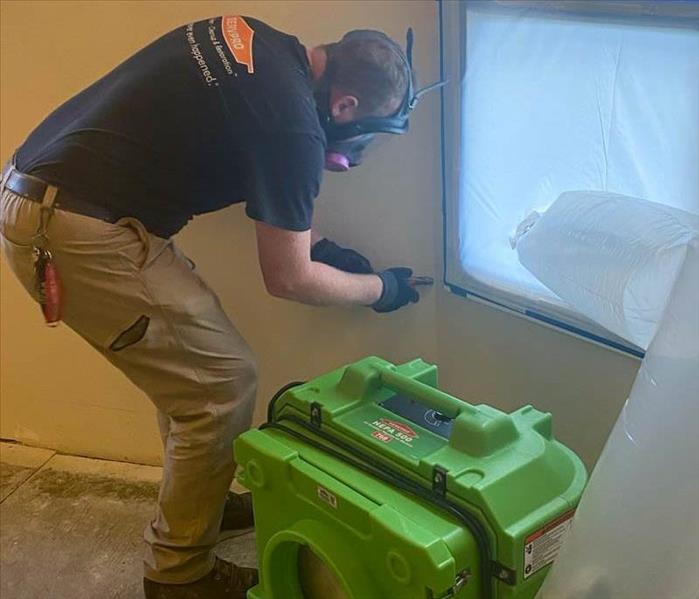 For expert water damage restoration services in San Diego, contact SERVPRO® of San Diego East today.
For expert water damage restoration services in San Diego, contact SERVPRO® of San Diego East today.
As a homeowner in San Diego, protecting your property against water damage is crucial. The city's proximity to the ocean and its susceptibility to rainfall make it susceptible to water-related issues. By enhancing your home's resilience and taking proactive measures, you can minimize the risk of water damage and its costly consequences. In this blog, we will provide you with valuable tips and strategies to safeguard your home against water damage in the beautiful city of San Diego.
1. Regular Roof Maintenance
Your roof is your home's first line of defense against water intrusion. Regular roof inspections and maintenance are essential to identify and address any potential vulnerabilities. Check for damaged or missing shingles, clean gutters, and downspouts regularly, and ensure proper attic ventilation to prevent condensation buildup. Investing in routine roof maintenance can significantly reduce the chances of water leaks during heavy rainstorms.
2. Proper Yard Drainage
San Diego's occasional heavy rainfall can lead to pooling water or flooding in your yard, which can eventually seep into your home's foundation. Ensure that your yard has proper grading to redirect water away from your home's foundation. Consider installing French drains, catch basins, or a rain garden to help manage excess rainwater and prevent water from accumulating near your property.
3. Maintain and Monitor Plumbing Systems
Leaking pipes and plumbing system failures can cause significant water damage if left unattended. Regularly inspect your plumbing for leaks, drips, or signs of corrosion. Ensure that everyone in your household knows the location of the main water shut-off valve in case of emergencies. Consider installing water leak detection systems that can alert you to any water leaks or abnormal usage, providing an early warning system against potential water damage.
4. Waterproofing Basements and Crawl Spaces
If your home has a basement or crawl space, it is important to take measures to prevent water intrusion. Inspect the walls and floors for any cracks or vulnerabilities and seal them with waterproofing materials. Install quality sump pumps and battery backups to prevent basement floods during heavy rainfall or plumbing emergencies. Properly ventilate and dehumidify crawl spaces to prevent moisture buildup and mold growth.
5. Install Flood Prevention Devices
Flash floods can occur during intense rainstorms. Installing flood prevention devices, such as backwater valves and sump pumps with battery backups, can provide additional protection against floodwater backup in your plumbing system. These devices help prevent sewage or stormwater from entering your home, reducing the risk of water damage during a flooding event.
By implementing these strategies, you can protect your property and minimize the potential devastation caused by water-related issues. Remember to prioritize regular roof maintenance, ensure proper yard drainage, monitor your plumbing systems, waterproof basements, and crawl spaces, and install flood prevention devices when necessary. If you do experience water damage despite your best efforts, don't hesitate to contact the water damage restoration experts at SERVPRO® of San Diego East. We are here to help mitigate and restore your property efficiently and effectively.
For expert water damage restoration services in San Diego, contact SERVPRO® of San Diego East today. Our experienced team is available 24/7 to assist you in your time of need.
Tips for Homeowners to Prepare for Storms in San Diego
9/17/2023 (Permalink)
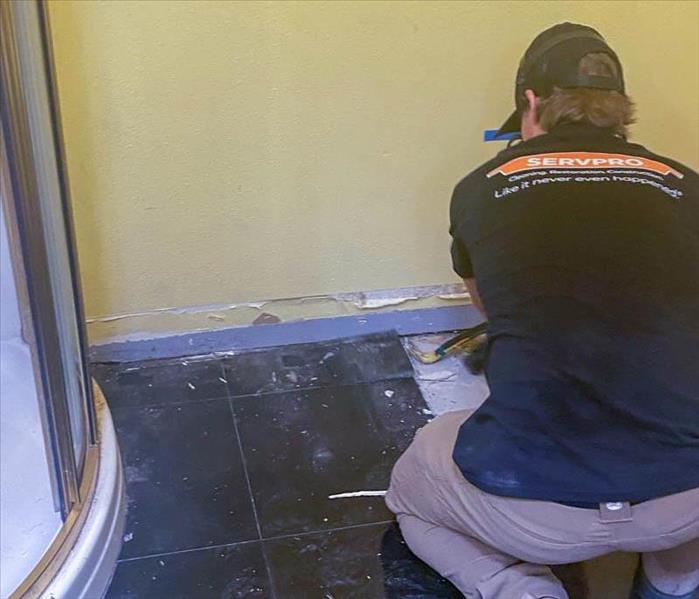 For professional storm damage restoration and cleanup services in San Diego, contact SERVPRO!
For professional storm damage restoration and cleanup services in San Diego, contact SERVPRO!
As storms can be a common occurrence in the San Diego area, it is crucial for homeowners to be prepared. In this blog post, we will share valuable tips and advice on how to effectively prepare for storms and minimize potential damages to your property. By implementing these proactive measures, you can ensure the safety and well-being of your loved ones and safeguard your home.
Understanding Storm Types in San Diego
Before diving into storm preparation, it is essential to understand the common types of storms that can affect San Diego. From rainstorms to windstorms and even the occasional tropical storm, each type can have different impacts on homes and properties. By knowing what to expect, homeowners can tailor their preparations accordingly.
Creating an Emergency Plan
Developing a family emergency plan is crucial to ensure everyone's safety during a storm. This plan should include designated meeting areas, emergency contact information, and a communication strategy. Identifying safe areas within your home, away from windows and exterior walls, is also important to protect against flying debris or structural damage.
Securing Your Property
When a storm is approaching, securing your property is vital to prevent potential damages. Reinforcing doors and windows, clearing gutters and drains, and securing outdoor objects such as patio furniture or garden equipment will help minimize the risk of property damage during high winds or heavy rain.
Protecting Important Documents and Valuables
In the event of a storm, it is crucial to protect essential documents and valuables. Creating digital backups of important files and storing physical documents in a waterproof and fireproof container will help ensure their preservation. Safeguarding valuable items such as jewelry, heirlooms, or sentimental objects is equally important.
Building an Emergency Kit
Every homeowner should have a well-stocked emergency kit that includes essential supplies such as flashlights, batteries, a first aid kit, non-perishable food items, and an ample supply of clean drinking water. Additionally, consider adding extra medications, a battery-powered radio, and personal hygiene items to your kit.
Staying Informed
Utilize local resources and alerts to stay informed about developing weather conditions. Keep track of weather updates, warnings, and evacuation notices through official emergency channels. These sources will provide real-time information and guidance to help you make informed decisions during a storm.
Evacuation Planning
In some cases, evacuation may be necessary for your safety. Therefore, it is crucial to familiarize yourself with the evacuation routes in your area. Plan ahead for any potential evacuation needs, especially if you have pets, by identifying pet-friendly hotels or shelters in advance.
After the Storm: Recovery and Insurance
After the storm passes, it is essential to assess any potential damages to your property and document them thoroughly. Take photographs and make a detailed inventory of all damages for insurance purposes. Contact your insurance provider to initiate the claims process and seek professional assistance, such as SERVPRO of San Diego, for storm damage restoration and cleanup.
By implementing the tips and guidelines provided in this blog post, you can proactively prepare for storms in San Diego and protect your home and family from potential damages. Remember, being prepared not only significantly reduces the impact of storms but also brings peace of mind during challenging times. Stay safe, stay prepared!
For professional storm damage restoration and cleanup services in San Diego, contact SERVPRO of San Diego East. Our dedicated team is here to help you recover and restore your property after storm-related disasters.
Rebuilding Security: Safeguarding Your Building After a Fire
8/2/2023 (Permalink)
Experiencing a fire in a building can be a traumatic event that poses significant challenges for the safety and security of the affected property. After a fire, it is crucial to take proactive steps to restore and enhance building security. In this blog post, we will explore essential measures to help you keep your building secure following a fire, ensuring the safety of occupants and preventing further damage or unauthorized access.
Evaluate Structural Integrity
Before addressing security concerns, it is vital to assess the structural integrity of the building. Engage professional inspectors and engineers to thoroughly evaluate the stability of the structure, identifying any potential hazards or areas requiring immediate attention. This evaluation will help determine the feasibility of reoccupying the building and guide the subsequent security measures.
Secure Entry Points
After a fire, it is essential to secure all entry points to prevent unauthorized access and protect the property from potential theft or vandalism. Evaluate and repair damaged doors, windows, and locks. Consider installing temporary security measures such as reinforced boarding or security screens if necessary. Make sure all access points are properly secured before allowing occupants or workers back into the building.
Install Temporary Fencing and Signage
If the building requires significant repairs or is temporarily uninhabitable, consider installing temporary fencing around the premises. This will act as a physical barrier to prevent unauthorized entry and signal that the building is under restoration. Additionally, prominently display signage indicating that the building is off-limits or undergoing repairs to deter potential trespassers.
Enhance Fire Protection Systems
A fire incident should serve as a reminder to review and enhance fire protection systems within the building. Coordinate with fire safety professionals to ensure that fire alarms, sprinkler systems, fire extinguishers, and emergency lighting are in proper working order. Conduct thorough inspections and testing to identify any deficiencies and promptly address them. Upgrading fire protection systems may be necessary to meet current safety standards and provide enhanced security against future fire incidents.
Implement Surveillance and Monitoring
To maintain security and deter criminal activities, consider implementing surveillance and monitoring systems. Install security cameras at strategic locations, such as entry points, hallways, and parking areas. Coupled with proper lighting, surveillance systems act as a deterrent and provide valuable evidence in case of any security breaches. Additionally, consider engaging professional security services to monitor the premises, especially during the restoration phase.
Develop an Emergency Response Plan
Having a comprehensive emergency response plan is crucial for building security after a fire. Collaborate with relevant stakeholders, such as building management, occupants, and local authorities, to develop an effective plan. The plan should include protocols for evacuations, reporting emergencies, contacting emergency services, and addressing security concerns. Regularly educate and train occupants on the emergency response procedures to ensure everyone is prepared and able to act swiftly in case of an incident.
Recovering from a fire incident requires diligent efforts to restore and enhance building security. By evaluating structural integrity, securing entry points, installing temporary fencing, enhancing fire protection systems, implementing surveillance and monitoring, and developing an emergency response plan, you can take proactive steps to keep your building secure and minimize the risk of further damage or unauthorized access. Prioritizing building security after a fire is essential for the safety and well-being of occupants and the long-term protection of your property.
Water Leaks Uncovered: Protecting Your Business from Costly Losses
7/13/2023 (Permalink)
Water leaks can wreak havoc on businesses, causing significant damage, financial losses, and disruptions to operations. Whether it's a burst pipe, faulty plumbing, or a leaky roof, water leaks pose a considerable risk to commercial properties. In this blog post, we will explore the impact of water leaks as the most common business losses and provide practical tips to prevent them. By understanding the risks and implementing preventive measures, businesses can safeguard their assets and minimize the potential for water-related disasters.
The Costly Consequences of Water Leaks
Water leaks in commercial properties can lead to various detrimental consequences. These include property damage, loss of inventory, equipment malfunction or damage, structural deterioration, mold growth, and potential health hazards for employees and customers. Additionally, business interruptions due to water damage can result in lost productivity, revenue, and customer trust.
Common Causes
Understanding the common causes of water leaks is crucial for prevention. Faulty plumbing, aging infrastructure, burst pipes, damaged or poorly maintained roofs, leaking appliances or fixtures, and inadequate drainage systems are some of the common culprits. Regular inspections and maintenance can help identify potential issues before they escalate into costly leaks.
Conduct Regular Inspections
Establish a proactive approach to identify and address water leak risks. Regularly inspect plumbing systems, including pipes, valves, and connections, to detect any signs of leaks or damage. Inspect the roof for cracks, missing shingles, or damaged flashing that could lead to water infiltration. Pay attention to areas prone to moisture, such as basements, bathrooms, kitchens, and utility rooms.
Maintain Plumbing Systems
Routine maintenance is essential to keep plumbing systems in optimal condition. Schedule regular inspections and maintenance with licensed plumbers to address any potential issues promptly. Replace worn-out parts, repair leaks, and ensure proper insulation to prevent freezing pipes in colder climates. Educate employees about reporting any signs of leaks or plumbing problems.
Ensure Adequate Drainage
Poor drainage systems can contribute to water leaks and damage. Regularly inspect and clear gutters, downspouts, and drains to prevent clogs and water buildup. Ensure that water flows away from the building's foundation to minimize the risk of water seepage.
Install Leak Detection Systems
Invest in advanced leak detection systems to monitor water usage and detect leaks in real-time. These systems can automatically shut off the water supply or send alerts when abnormal water flow or leaks are detected. Early detection can significantly reduce the extent of damage and mitigate losses.
Educate Employees
Raise awareness among employees about the importance of water conservation, leak detection, and reporting. Encourage them to promptly report any signs of leaks or water-related issues they notice. Training employees on basic water management practices, such as turning off faucets tightly and reporting dripping fixtures, can contribute to leak prevention efforts.
Review and Update Insurance Coverage
Regularly review your insurance coverage to ensure it adequately protects your business against water-related losses. Understand the scope of coverage for water damage and any specific exclusions or limitations. Consider additional endorsements or riders to your policy if necessary to enhance protection.
Develop a Water Emergency Plan
Prepare a comprehensive water emergency plan that outlines the steps to be taken in the event of a water leak or flood. Designate responsible personnel to handle emergency situations, including contacting appropriate professionals and coordinating cleanup and repairs. Ensure the plan is accessible and known to all employees.
Water leaks pose a significant risk to businesses, causing extensive damage and financial losses. By understanding the common causes of leaks and implementing preventive measures, businesses can reduce the likelihood of water-related disasters. Conduct regular inspections, maintain plumbing systems, ensure proper drainage, install leak detection systems, educate employees, review insurance coverage, develop a water emergency plan, and seek professional assistance when needed. Taking these proactive steps will help businesses protect their assets, maintain continuity, and minimize the impact of water leaks as common business losses. Engage the services of professional water damage restoration companies to handle any water leaks or damage promptly and effectively. These experts have the expertise, equipment, and experience to mitigate the damage, restore affected areas, and minimize business disruptions.
How to Protect Your Building from Storm Damage
6/19/2023 (Permalink)
Storms can wreak havoc on buildings, causing significant damage and disrupting daily operations. Protecting your building from storm damage is essential to ensure the safety of occupants and preserve the integrity of the structure. In this blog post, we will discuss effective strategies and practical tips to help you fortify your building against storm damage, empowering you to weather the storm with resilience.
Conduct a Thorough Building Inspection
Start by conducting a comprehensive inspection of your building to identify areas vulnerable to storm damage. Look for signs of wear and tear, such as loose roof shingles, damaged siding, or weakened windows. Address any existing maintenance issues promptly to reinforce the building's resilience against storms.
Reinforce Doors and Windows
Strengthening doors and windows is crucial in protecting your building from storm-related impacts. Install impact-resistant glass or storm shutters to safeguard windows. Reinforce doors with heavy-duty locks, hinges, and sturdy materials. Consider installing bracing systems to reinforce garage doors and prevent them from collapsing under high winds.
Maintain Gutters and Downspouts
Keep gutters and downspouts clear of debris to ensure proper water drainage during storms. Regularly clean and inspect them, removing leaves, twigs, and other obstructions that could cause blockages. Ensure downspouts direct water away from the building's foundation to prevent water infiltration.
Secure Outdoor Equipment and Furniture
Secure outdoor equipment, furniture, and other loose items to prevent them from becoming projectiles during storms. Anchor or store items such as patio furniture, grills, and trash cans in a secure location. Trim tree branches near the building that could potentially break and cause damage.
Reinforce Roofing and Siding
Inspect the roof and siding for any signs of weakness or damage. Repair or replace loose or missing shingles, tiles, or panels. Reinforce roof edges and vulnerable areas with sealants or weather-resistant materials. Ensure the siding is properly installed and sealed to withstand strong winds and heavy rainfall.
Enhance Drainage Systems
Evaluate the building's drainage systems to effectively manage water flow during storms. Ensure proper grading around the foundation to direct water away from the building. Install or maintain French drains, swales, or other drainage solutions to prevent water pooling near the structure.
Backup Power and Emergency Systems
Consider installing backup power systems, such as generators, to maintain essential functions during power outages caused by storms. Have a designated emergency power plan in place to ensure critical systems like alarms, emergency lighting, and communication devices remain operational.
Develop an Emergency Response Plan
Create an emergency response plan tailored to storm-related scenarios. This plan should include evacuation procedures, designated assembly areas, communication protocols, and responsibilities for building occupants. Regularly train and educate staff on the emergency plan to ensure a swift and coordinated response during storm events.
Review Insurance Coverage
Review your insurance coverage to ensure it adequately protects your building against storm damage. Understand the policy terms, deductibles, and coverage limits. Consider additional coverage options if necessary, such as flood insurance or business interruption insurance, to address specific risks associated with storms.
Protecting your building from storm damage requires proactive measures and careful planning. By conducting thorough inspections, reinforcing doors and windows, maintaining gutters and downspouts, securing outdoor equipment, reinforcing roofing and siding, enhancing drainage systems, installing backup power, developing an emergency response plan, and reviewing insurance coverage, you can significantly reduce the potential impact of storms on your building. Remember, regular maintenance and preparedness are key to ensuring the safety and resilience of your building in the face of severe weather conditions.
Everything You Need to Know About Testing for Mold in Your Home or Workplace
5/8/2023 (Permalink)
Mold is a type of fungus that grows in warm, damp environments. It can be found almost anywhere, but it's particularly common in homes with poor ventilation or with moisture problems. There are many different types of mold and they all look different depending on what they're growing on (wood, paper or fabric).
Mold can grow almost anywhere there is water damage, under sinks or bathtubs and between walls and floors. Behind cabinets or baseboards, in attics where insulation has been wet by rainwater leakage through roof shingles and even inside your refrigerator if food spills over onto shelves that aren't cleaned regularly enough!
Signs of Mold
- Musty odors
- Visible mold growth (e.g., black-green stains)
- Discoloration on walls or ceilings
Testing for Mold
There are several ways to test for mold. The first and most obvious is visual inspection, which can be done by anyone with a trained eye and an understanding of what they're looking at. The second method is using a mold test kit, which allows you to collect samples from your home or workplace and send them off for lab testing. A third option is hiring a professional inspector who will come out to perform tests on site and give you their expert opinion about what's going on in your space.
Preventing Mold Growth
Reduce humidity levels. The ideal relative humidity for most homes is between 30% and 50%. If you have a dehumidifier, use it to reduce the moisture in your home. If you don't have one, try to keep windows open when possible and run fans during humid weather.
In order to ensure that your home is safe, it is best to hire a professional mold remediation company. These companies are trained in removing affected materials and cleaning up the affected area. They will also be able to tell you if there are any other areas of concern in your home that need attention.
Effective Cleaning
If you choose not to hire a professional company, then make sure that you follow these steps. Remove all affected materials from the house (such as drywall or carpeting). Clean and sanitize all surfaces with soap and water before replacing them back into place; this includes walls, ceilings, floors etc.
Protecting Your Employees During Mold Removal
It is essential to protect your employees during mold removal. Follow safety protocols. Wear protective gear, including full body suits and respirators. Provide air filtration systems in the area where you're working to keep mold spores from spreading throughout your workplace or home.
Mold can grow almost anywhere there's moisture. The best way to prevent mold growth is by keeping surfaces dry by using fans during humid weather, keeping humidity levels low inside homes/offices using dehumidifiers when necessary, and call a professional if you think your property suffers from mold damage in the workplace.
The Essential Guide to Commercial Fire Cleanup: Steps to Restore Your Business
4/5/2023 (Permalink)
A commercial fire can be devastating to any business. Not only can it cause physical damage to the property, but it can also lead to the loss of important documents, equipment, and inventory. Additionally, it can result in significant downtime, lost revenue, and a damaged reputation. That is why it is essential to have a solid plan in place for commercial fire cleanup. In this blog post, we will outline the key steps involved in the commercial fire cleanup process.
Step 1: Safety First
Before anything else, safety should be the top priority. The first step in the commercial fire cleanup process is to ensure that everyone in the affected area is safe. This may involve shutting off power or gas, assessing the structural integrity of the building, and making sure that there are no hazardous materials present. A professional fire restoration company will have the experience and expertise to handle these safety precautions.
Step 2: Assess the Damage
Once safety has been established, the next step is to assess the extent of the damage. This includes evaluating the damage to the structure itself, as well as any damage to inventory, equipment, and documents. An experienced restoration company will conduct a thorough evaluation of the damage to determine the best course of action.
Step 3: Secure the Site
After the damage has been assessed, the next step is to secure the site. This may involve boarding up windows and doors, fencing off the area, and taking other steps to prevent unauthorized access. This is an essential step to prevent further damage or theft from occurring.
Step 4: Remove Debris
The next step in the commercial fire cleanup process is to remove debris from the affected area. This may involve removing charred materials, ash, and other debris from the building. It is essential to remove this debris quickly to prevent further damage to the structure and to reduce the risk of fire or other hazards.
Step 5: Clean and Restore
After the debris has been removed, the next step is to clean and restore the affected area. This may involve cleaning carpets and upholstery, replacing damaged drywall and insulation, and repainting walls and ceilings. It may also involve restoring any equipment or inventory that has been damaged by the fire.
Step 6: Final Inspection
The final step in the commercial fire cleanup process is a final inspection. This involves a thorough review of the restoration work to ensure that everything has been completed to the highest standards. This step is essential to ensure that the building is safe for occupancy and that all necessary repairs have been made.
In conclusion, the commercial fire cleanup process is a complex and challenging task that requires experience, expertise, and a solid plan. Hiring a professional restoration company is essential to ensure that the process is handled efficiently and effectively. By following these key steps, you can help to minimize the damage caused by a commercial fire and get your business back up and running as quickly as possible.
Accidental Fire Sprinkler Activation
3/8/2023 (Permalink)
It's a scary thing when the fire sprinklers go off at your place of business. You're probably wondering if you'll ever get things back to normal. Luckily, there are some steps you can take that will help minimize the damage and get things back to normal as quickly as possible.
Where did the fire sprinklers go off?
If you're like most people, the first thing you'll want to know is where the water came from. In many cases, it's clear that a fire sprinkler has gone off. If there's no visible sign of damage or flooding and only one or two sprinklers have been activated, then it's likely that the cause was an accidental activation.
What is the source of the water? A simple way to determine whether your facility has been affected by an accidental activation is by checking for signs of damage in areas where sprinklers should not be installed. Electrical panels or air conditioning units, and seeing if any of these items have been damaged by dripping water. What are the consequences of this loss? The amount of damage will vary depending on how much water was lost through each individual sprinkler head during its cycle.
How much water has been lost?
The amount of water lost will depend on the type of sprinkler system and how long it was in operation. If you don't know how much water has been lost, contact your fire protection company immediately.
Was the loss intentional or accidental?
If the fire sprinklers went off accidentally, you should call a professional to assess the damage. The person who turned them on may or may not be liable for any associated costs and damages. If they were intentionally activated and there is no fire, then you should also call the fire department immediately as well.
Getting things back to normal as quickly as possible?
First thing to get things back to normal quick is call the fire department. Upon arrival call a restoration company to quickly access the damage. Turn off all power to your building and shut off water to affected areas. Remove all valuables from affected areas, including computers, paperwork and anything else that might be damaged by water or fire.
Clean up any standing water with towels or mops, and use air movers and dehumidifiers to help reduce water damage and potential secondary damages.
Plan in place
If you have fire sprinklers in your building, you should have a plan in place to deal with them. This can include things like, having someone who is responsible for checking the water levels on a regular basis and making sure they're not getting too low, especially during times when there are fewer people working at the office or school.
Keeping an eye out for any signs that something might be wrong with a sprinkler (like leaks) so that it can be fixed before there's any damage done to anything else nearby.
Having someone ready to turn off all power sources if they feel unsafe while working near water levels that are too high due to malfunctioning equipment or other issues related directly back up into their electrical systems. You'll want everyone working together so everyone knows what needs doing immediately after hearing those fateful words "Fire Sprinklers Activated."
In the event of an accidental fire sprinkler activation, you should survey the damage and determine whether or not it was intentional. If it was, then you should call 911 immediately and let them know. If it wasn't intentional then there may be some steps that can be taken by yourself or with help from professionals to clean up the mess and restore things back to normal as quickly as possible.
5 Steps to prevent Commercial Fire
2/11/2023 (Permalink)
Fires in commercial kitchens can be devastating. They can destroy property, injure employees or customers, and financially impact your business. There are many things you can do to prevent a commercial fire from happening. Here are five steps that will help you lower your risk.
Keeping your kitchen clean and organized
Keeping your kitchen clean and organized is important to ensure your business is safe from potential fire damage. Clean up spills immediately. Spilled food on the floor, countertops, and cooking equipment can cause a fire. Keep flammable materials away from heat sources and flames. Keep your kitchen well lit so you can easily see the contents of any pots or pans that are bubbling on stovetops or countertops. Ensure to keep paper products placed far enough for them themselves not only to potentially catch fire but also potentially spreading flames further into nearby areas within seconds after being ignited by nearby burners or stoves.
Clean your oven and stove top regularly
To prevent a commercial fire from starting in your kitchen, you should clean your oven and stove top regularly. Keeping grease splatters and potential spills cleaned up off the stove top or in the bottom of the oven can significantly reduce the potential for fire.
Restrict cooking time
Fire marshals have been limiting the hours of operation for restaurants and other commercial kitchens to prevent fires. During off-hours, you should ensure that your kitchen is free of cooking materials such as propane tanks, deep fryers, or grills.
When cooking begins again in the morning or after a break, make sure that all equipment is completely cooled before leaving. Ensure any pilot lights are turned off before leaving the premises at night and never leave food unattended while it's being heated after a break.
Have a fire extinguisher on hand
The first step to preventing a fire is to have a fire extinguisher on hand. The ideal location for this safety tool is in the kitchen, but it's also good to have one near your office or anywhere else flammable materials are stored.
If you're not familiar with how to use an extinguisher, read the instructions on its label before attempting to use it. Ensuring that your fire extinguisher is still in good condition is crucial—the expiry date should appear clearly on its label alongside other important information such as operating temperature range and minimum discharging pressure requirement for safe usage by end users.
Create a safer kitchen environment
Ensuring you have a safe kitchen environment is important to keep from potential fire or water damage. Install a fire alarm and smoke detector in each store location, as well as in the kitchen area to prevent a fire. Create a fire safety plan for your business that includes:
- An order of evacuation (if there is one) and number of people to evacuate
- an evacuation route from each building
- how to notify local emergency responders if needed.
Cooking is one of the most dangerous things people do in their businesses each day. The best way to avoid kitchen fires is to keep your stovetop and oven clean and free from grease build-up. You should also make sure that everyone in your business knows how to use an extinguisher in case there’s ever a fire emergency. Finally ensuring you have a safe kitchen environment can cut back on your chances of a fire breaking out and damage to your property.
Mold 101: Covering the Basics
1/24/2023 (Permalink)
Mold is a fungus that can grow in any damp area of your home and it's not always easy to identify. This guide will help you understand what mold is, where it comes from and how to get rid of it permanently.
What is Mold?
Mold is a fungus that reproduces by making spores. Spores are microscopic and can be invisible to the naked eye. Molds come in all shapes, sizes, and colors. They may be fuzzy or moldy looking and they will usually be some shade of green, black, white, or gray.
Molds reproduce by making spores that spread through the air and settle on surfaces where they can germinate into colonies of the mold with new generations of spores that continue to spread throughout your home or office space.
Where Does it Come From?
Mold is found everywhere, even in the air we breathe. It's also present in our food and on our pets. In fact, mold doesn't need to eat anything to survive — it can grow on wood, paper, and other organic material as long as there is moisture present.
Mold grows best when there's plenty of moisture around (think humid environments), but it can also grow in dry areas if they're warm enough. It will thrive in wet areas such as bathrooms or kitchens where there are leaks from pipes or roof damage; basements with poor ventilation; floors covered with damp carpeting; roofs with leaky gutters; under sinks without adequate drainage holes and windows without screens.
How Does it Spread?
Mold spores are microscopic and float through the air. They can travel through ventilation systems, be carried on shoes, clothing, and other personal items, or be carried by pets.
When it Comes to Mold, Knowledge is Power
Mold spores are everywhere; they're carried by air currents and wind, so no place is completely free from mold contamination—you just have to use common sense when determining if you need professional help to clean up an infestation problem.
It’s important to know exactly where mold comes from and how it spreads so you can protect yourself and your family. If you have any questions about removing mold from your house, please feel free to contact us here at SERVPRO of San Diego East for more information!
What Are 3 Types of Common Biohazard?
12/5/2022 (Permalink)
3 Types of Common Biohazards
A biohazard is any biological material that poses a risk to human health. It can be caused by microorganisms (bacteria, viruses, or fungi), wastes or toxins. Biohazardous materials include waste products from laboratory animals and humans, human blood and body fluids, infectious agents like bacteria and viruses used in research labs or clinics.
What is Biohazard?
Biohazard is a term used to describe biological hazards that can cause infection or disease. Biohazard also refers to waste products and toxins that are potentially infectious.
Biohazards can be found in many places in the home, office, or workplace.
Biohazardous diseases: viruses, bacteria, and other microorganisms.
- Viral diseases
- Bacterial diseases
- Parasitic diseases
Biohazardous substances: waste products and toxins.
Biohazardous substances are common, too. However, unlike biohazardous waste, these things aren't thrown out with regular trash or recycled. Biohazardous substances have the potential to cause injury and illness because they contain pathogens that can be transmitted through contact with a human body or personal possessions (like clothing). Examples of biohazardous substances include blood and other bodily fluids; any substance that contains blood; needles and syringes; dead animals; infected plants or plant material (including soil); insects; animal carcasses; medicines and vaccines; food products that may be contaminated with bacteria or viruses (e.g., unpasteurized milk).
Biohazardous waste: biological materials that are either infectious or potentially infectious
Biohazardous waste is any biological material that is infectious or potentially infectious. Examples of biohazardous materials include blood, urine, feces, and vomit. Even though these are not the only types of biohazardous waste and there are other types of hazardous wastes which we will discuss shortly, it’s best to think about this type first because it’s so widely used in the medical field.
Examples of Biohazard Safety Levels
The EPA's Universal Waste Rule defines biohazard waste as any biological material containing potentially infectious materials that are regulated by the Federal government. Biohazard safety levels are determined by the potential for infection and include:
- BSL-1: Low risk of disease transmission.
- BSL-2: Moderate to high risk of disease transmission.
Biohazardous waste is a serious issue that deserves our attention. If you know someone who has been diagnosed with a biological disease, it’s important to be aware of what types of waste they may produce as well as how to dispose of them properly.
Cleaning Up Water Damage In Your Home
11/1/2022 (Permalink)
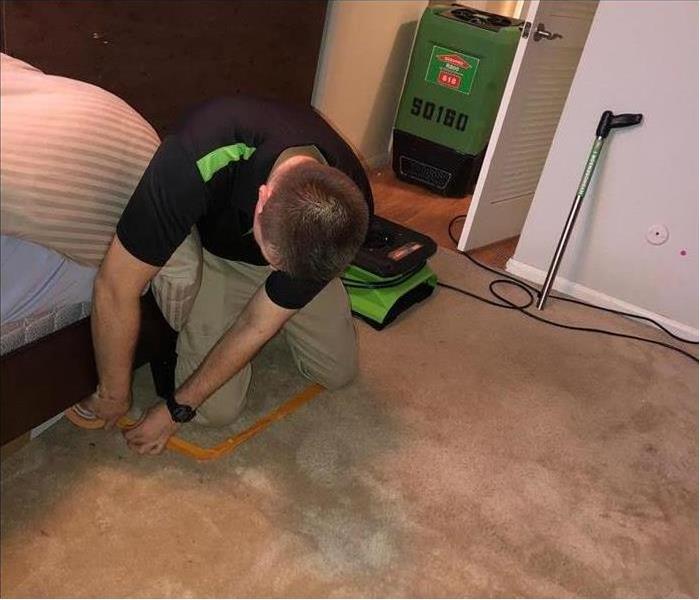 San Diego water damage
San Diego water damage
Water Damage Tips
Water damage is a serious problem that can strike at any time and cause costly, long-term damage to your home. If you've ever had to deal with water damage in your house, you know how quickly things can go from bad to worse if you don't act fast. So, what steps should you take after a pipe breaks or an appliance starts leaking? Here's what you need to know about cleaning up water damage in your home!
Water damage is a serious problem that can strike at any time. Is your home prepared?
Have you ever wondered what to do if you suspect water damage? If you have, then this expert guide will help.
What to Do if You Suspect Water Damage:
- Check the ceiling and walls for signs of moisture or discoloration. If they're wet or showing signs of mold, it's time to call in professionals like our team at SERVPRO. We'll assess your situation and let you know how best to proceed.
- Never use hot water extraction methods on your own; these methods aren't safe for untrained individuals who don't have access to the proper equipment and training required for their execution.
If a pipe in your house breaks, turn off your water supply at the main valve right away to stop further water damage.
Here are some tips from the pros on how to deal with a water emergency in your home:
- Turn off your water supply. If a pipe in your house breaks, turn off your water supply at the main valve right away to stop further water damage.
- Turn off the heater. If you have a gas-heated home, it's important to shut off or reduce power (if possible) to any heaters that may be affected by the flooding.
- Shut down electrical appliances in affected areas. It’s often not safe for you or anyone else to be around electrical equipment during cleanup because of potential electrical hazards like live wires and short circuits – so let professionals handle those repairs.
- Don't turn on any faucets until after they're dried out completely; this will help prevent any bacteria growth inside of them while they're still wet.
Don't hesitate to call a professional for help. It's better safe than sorry when it comes to water damage.
When you have a water damage issue, it's tempting to try and tackle things yourself. But it's important to realize that you may not be able to tell the extent of the damage or what kind of long-term effects there might be from water lingering in your home. It's better to be safe than sorry by calling a professional who can help resolve the problem for you and make sure everything is resolved properly.
Professional water damage cleanup is the way to go after any major leak or flood situation.
After a flood or leak, it's important to get the job done as quickly and efficiently as possible to prevent further damage. Professional water damage clean-up services are equipped with the tools and knowledge necessary to remove all your worries about the cost or time it will take to fix your property. If you choose not to hire a professional service, you may end up spending much more money on repairs than you would have by calling in the pros.
It is also important that you take care of any mold problems before they happen so that they don't spread throughout your home or office space. If left unchecked, mold can cause serious health problems such as respiratory issues and even death in some cases!
We hope this article has been helpful, and we wish you the best of luck in keeping your home safe from water damage. If you have further questions or concerns about any aspect of water damage repair, please contact us.
Who Pays for Fire Damage in a Rental Property?
10/1/2022 (Permalink)
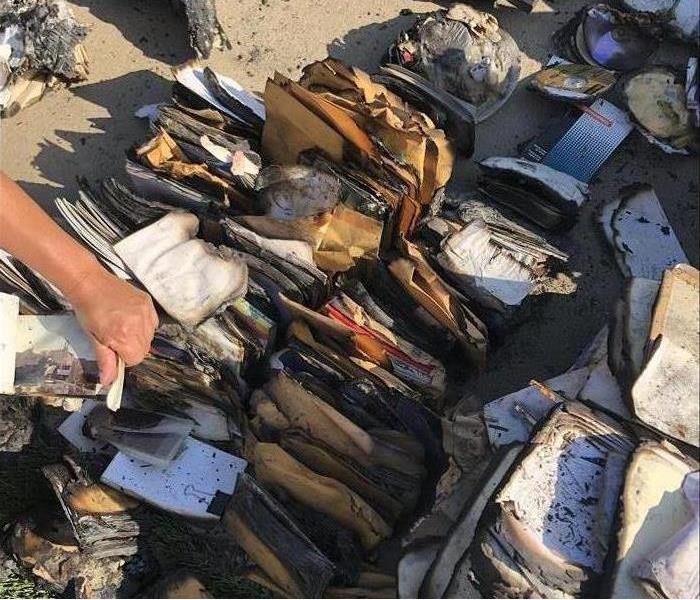 Files damaged in a home fire.
Files damaged in a home fire.
Who Covers Damage from a Fire in a Rental Property?
Fire damage is a scary and intimidating event. When it happens, a lot of people ask this question: “Who is responsible in case of fire damage in a rental property. The answer is that both the renter and the landlord are responsible for different parts of the building and its contents. Let’s dig deeper into the details.
The Landlord’s Responsibilities:
The landlord is responsible for all structural damages caused by fire or other natural disasters that occur on their rental property like hurricanes, floods, or earthquakes. The tenant has full responsibility for their personal belongings and can file an insurance claim through their renter's insurance policy if they have one. If you need help understanding what your rights are during this stressful time, please feel free to reach out to us anytime (619) 280-2377.
Structural Damage to The Property
If the tenant's negligence was to blame for the fire, they will likely have to bear all the costs associated with repairs. However, if there were no known causes of ignition or negligence on behalf of the tenant and/or their guests or visitors, then it’s possible that your landlord may be held responsible for some expenses related to repairs following a fire at their rental property.
The first step in determining who pays for fire damage in a rental property is figuring out whether your landlord’s policy covers structural damages—the damage caused by fire spread through walls and floors rather than just flames themselves. Most insurance policies cover this type of structural damage if it is caused by external factors (like lightning strikes).
Personal Belongings
It’s important to know that renters’ insurance covers your belongings. If you rent an apartment and want to make sure your personal property is protected, it’s a good idea to invest in renters’ insurance.
This type of policy can be expensive, and landlords aren't required by law to ask tenants what kind of coverage they have. But it's still worth considering—especially if you're replacing expensive items like laptops or jewelry.
You can buy renters insurance online or through an independent broker who specializes in this type of coverage.
The tenant has full responsibility for their personal belongings.
If you are a tenant, your insurance should cover damage to your personal belongings. This is an optional service that is usually very inexpensive, and it is a good investment if you want to avoid paying out of pocket for damages.
Even if the landlord has insurance on the property, they are not responsible for damage to your personal belongings unless there was negligence involved (for example: someone else caused the fire at the house). In this case, the landlord's insurance will take care of anything that happened during their time of ownership and responsibility over the property. However, if there was no negligence involved in causing damage to one's personal possessions then tenants have full responsibility for their own things through their renters' policy or homeowners' policy with an endorsement stating content coverage while away from home.
The most important thing to remember is that both the tenant and landlord are responsible for certain parts of the building and its contents. If you need help understanding your responsibilities, contact us today!
4 Fire Safety Tips for Your Home
8/30/2022 (Permalink)
Fire Preparation For Your Home
If a fire breaks out in your home in College West, CA, it can be deadly and cause lots of damage. However, by implementing fire preparation measures, you can minimize the risks. To help you get started, here are four tips that you can begin using today.
1. Make Smoke Alarms a Priority
Smoke alarms are essential tools you can use to prevent a home fire. They should be installed throughout your house, especially in and near the bedrooms. Test your alarms monthly and replace the batteries once a year. Also, never disable them, especially when you are cooking.
2. Use Electrical Appliances Safely
Check and replace damaged cords or wires on your appliances and other electrical items. Give devices such as lamps and space heaters proper space to prevent them from overheating. And never leave them on overnight or while you’re away from home.
3. Teach Your Children About Fire Safety
A big part of fire preparation is teaching your children the dangers of playing with fire. Keeping matches and lighters out of their reach will also help with this issue. You should also protect your little ones by installing safety caps over outlets. These simple tools will prevent them from sticking items into a wall socket and starting a fire or electrocuting themselves.
4. Have an Escape Plan
Create an escape plan for your family and practice it at least twice a year. Ensure it includes two ways to escape each room and a place to meet up once everyone gets out of the house. Also, make sure everyone knows to never go back in for important items. You can assure them that a trained restoration specialist will do their best to preserve your family photos and other sentimental things after the fire.
The best way to prevent a fire in your home is to prepare for it. Fire preparation is vital for the safety of your family and your home.
Water Conservation Upgrades
8/27/2022 (Permalink)
Water conservation can make a big difference in your building's profitability. Upgrading your commercial property in Grantville, CA, to prevent leaks and minimize waste is an excellent investment. You'll help the environment and your bottom line while preventing expensive water damage.
Common Water Issues
Irrigation Mismanagement
Aging Appliances
Wasteful Fixtures
Rethink Your Irrigation
Irrigation is necessary to maintain your landscape, but it's also where you are probably wasting the most water. Here are some tips to help you conserve.
1. Maintain your irrigation system properly. This means inspecting it for leaks from cracks, worn fittings or washers, and poor connections. Water damage restoration experts agree that repairing water problems in a timely fashion is much less costly than repairing your building after a flood.
2. Only water when necessary. Over-watering is one of the simplest water issues to solve. Put in a sensor to prevent watering when the ground is moist or the weather is wet. Experiment with watering less often or for less time.
3. Select lower-maintenance plants. Drought-tolerant native plants require very little water and will thrive year after year.
Replace Older Appliances
It's not cost-effective to run out and purchase new appliances solely to conserve water. However, when it's time to replace that old dishwasher or washing machine, select replacements with energy use and water consumption in mind.
Select Efficient Fixtures
Consider touch-free faucets for an excellent water upgrade. While they do cost more upfront, you will eliminate one of the worst water issues: taps left running.
Swap the flush valves in your toilets. You may be using up to 5 gallons per flush. New valves use about 25% of that.
Update your aerators. This is a very cost-effective improvement and can save about half of the water used for washing hands.
Conserving water saves money. Maintaining equipment prevents water seepage and flood damage. Take control of the water usage in your building to improve your profitability and keep your property running efficiently.
Simplify Fire Restoration with SERVPRO
8/22/2022 (Permalink)
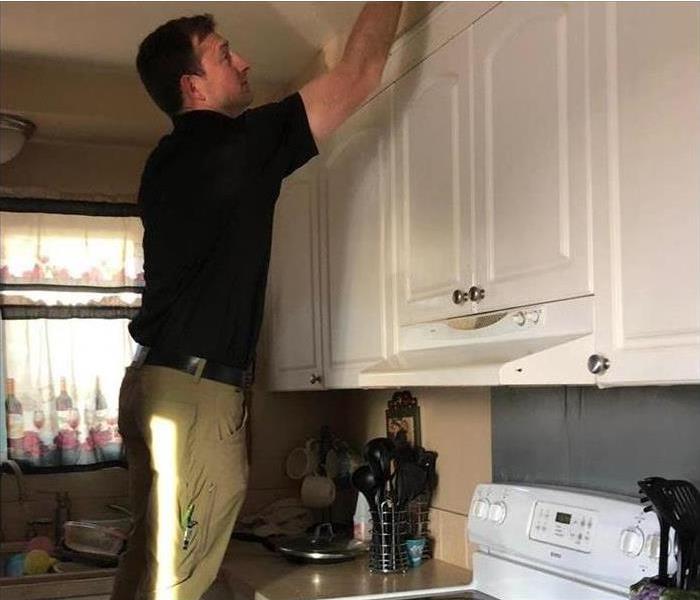 A local team is always ready to help you regain your pre-fire home
A local team is always ready to help you regain your pre-fire home
Fire Restoration Process
How do you pick up the pieces after a fire in your Allied Gardens, CA, residence? It's important to start restoration work immediately to prevent further damage or irreversible odors. Quickly resolve damage and cleanup problems by calling SERVPRO, the leading expert in fire mitigation and restoration. A local team is always ready to help you regain your pre-fire home. Here are the main steps in the fire restoration process.
1. Phone Consultation
We're available 24/7 for you to contact us about fire damage restoration. An expert will ask you questions to assess the situation and determine what resources they will need to help you.
2. In-Person Inspection
A SERVPRO team member will arrive on-site to assess the damage to your residence and create a fire rebuild plan.
3. Initial Fire Restoration Measures
If your residence's structural integrity is damaged, SERVPRO will install tarps and boards to protect against weather, animals and intruders. This procedure also gives technicians more time to survey damaged areas before starting repairs.
4. Water and Smoke Damage Removal
The next step of the fire damage restoration process involves drying any water-damaged structures and belongings. Technicians also detoxify your residence by removing soot and smoke from contaminated surfaces such as floors and ceilings.
5. Cleaning and Deodorizing
SERVPRO thoroughly cleans and deodorizes the residence and any damaged possessions before proceeding to more in-depth repair work.
6. Rebuilding Services
The last stages in fire damage restoration are rebuilding and refurbishing. Minor repairs may include painting, the installation of new fixtures and other surface-level improvements. Some restoration projects may require major reconstruction of entire rooms or sections of the residence.
Recovering from a residential fire doesn't have to be overwhelming. Simplify fire restoration by coordinating with your local emergency services. SERVPRO will quickly and efficiently help return your residence to its pre-fire state.
When To Repair a Roof With Storm Damage
7/27/2022 (Permalink)
When Should a Storm-Damaged Roof Be Repaired?
"As soon as possible" is the short answer when it comes to roof repair. If a number of residences have sustained storm damage or prolonged inclement weather is expected in Del Cerro, CA, mitigation measures such as tarping over damage can help to protect your roof from further hail or wind damage and keep out moisture that might otherwise end up causing damage inside the structure.
After Documenting Damage
If the roof of your home is well-maintained, it may be possible to make a homeowners insurance claim to cover roof damage. If you plan to do so, you should take measures to document damage:
- Get an expert opinion
- Take photographs
- Record video footage
Once you have captured evidence of storm or wind damage, you should immediately arrange for mitigation or repairs. Mitigation measures can limit damage until repairs take place.
After Mitigation Measures
A damage restoration or roofing company may offer damage mitigation services to prevent further damage prior to roof repair. The most common measure involves tarping over a roof:
• Acquire a tarp large enough to cover damage and extend three feet over the ridge
• Wrap the tarp around plywood and secure with deck screws or nails
• Use strapping to tie down the tarp
A tarp can protect a roof surface and the interior of a home from further damage. Insurers seek proof that homeowners have taken every measure they can to limit the damage. Mitigation is helpful for making an insurance claim and reducing the cost of restoring primary and secondary damage.
A homeowner should try to schedule roof repair immediately after damage occurs, ideally within hours or days. Fixing any roof damage can be costly, but expenses will escalate as the damage becomes worse and potentially affects the interior of a residence in Del Cerro, CA. If this occurs, homeowners should contact a roofer and a storm damage restoration service.
How To Prepare for Water Damage With Business Insurance
7/20/2022 (Permalink)
Preparing for Water Damage with Business Insurance
As a small business owner in San Carlos, CA, you need to be ready for anything. When water unexpectedly gets into places it is not supposed to, it can cause major problems. Almost all businesses, at least the ones with physical locations, are vulnerable to water damage, which can occur from things such as:
- Broken pipes
- Severe weather
- Damaged HVAC systems
- Foundation leaks
You can reduce costs and prepare for any issues caused by water by having insurance coverage for your commercial property.
Different Policies Cover Different Types of Costs
Dealing with water damage at your business is never fun, but there are a few different business insurances you can use. Commercial flood insurance, business income insurance and standard commercial property insurance policies are good options to have in times of crisis. Insurance companies can be a proper resource with the right policies; however, the source of the damage often determines the level of coverage you will have. Standard commercial policies will usually cover claims for burst pipes, but additional insurance could be needed for other causes and potential revenue losses.
Insurance Companies Can Assist With Water Cleanup
Insurance companies often work closely with cleanup and restoration professionals. These companies can provide water and material cleanup and emergency services such as mold remediation if needed. Damage assessment performed by these professionals can be directly used to help with filing your insurance claim so you can get back in business as soon as possible. It's worth having a conversation with your insurance agent about your policy's features to ensure you have the best protection and restoration plan in place.
No matter the cause of water damage, it is always best to jump in front of a possible emergency. Getting business insurance is a great way to save your business, time and money.
The Importance of Drying Time
7/15/2022 (Permalink)
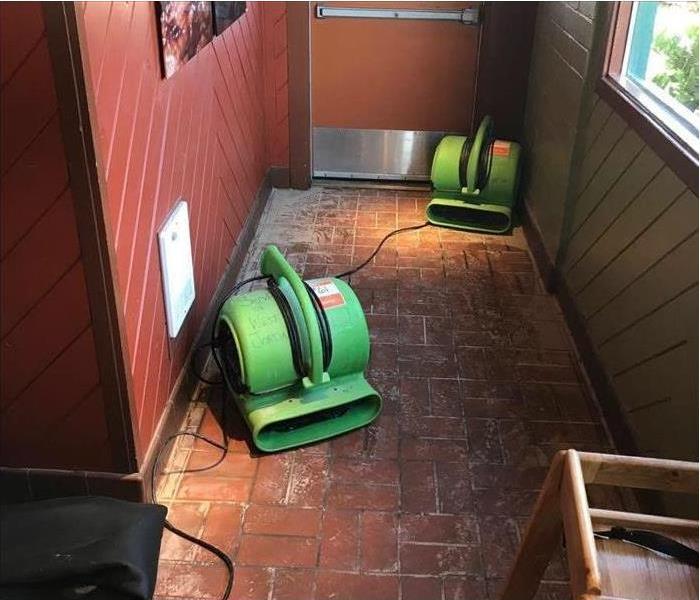 SERVPRO technicians drying a restaurant.
SERVPRO technicians drying a restaurant.
The Importance of Drying Time
Before starting the remediation process during any water outbreak the drying process must be handled first. Drying time is important because residents can get their homes back into shape, business owners can start selling again, and cutting costs is ensured for insurance companies.
Drying time is the average number of days between the first air mover or dehumidifier being placed on-site until the last air mover or dehumidifier is removed from the job site. SERVPRO follows the IICRC S500 Standards in order to give customers the best drying time. There are three levels of drying time expectancy there are less than five days which falls under green, between five to seven days is yellow, and finally, more than seven days which lands in red. Our goal is to always have drying time in the green zone.
What causes a delay in drying time?
There are multiple factors that can cause a delay in the drying time. One of the most common factors is when residents or property owners unplug the air mover or dehumidifier. Unplugging appliances will surely increase the time needed to dry this also causes water to sit on surfaces which will cause the spread of mold and will further the damage to surfaces resulting in higher costs. Definitely do not unplug appliances.
Another cause of delayed drying time is moving appliances. When technicians set the appliances for drying time they are placed in areas that are most wet. This is not noticeable to the human eye therefore water levels are measured with water mapping tools for the most accurate drying placement.
Another common factor that may cause drying time is storms or more water leakage. Storms are definitely out of our control so make sure the technician that is working on your case is notified quickly to prevent further damage. If you had a water leakage make sure the water source is shut off every time water is not needed to be in use.
3 Ways To Reduce the Water Consumption in Your Business
6/26/2022 (Permalink)
Three Ways To Reduce the Water Consumption in Your Business
Running a business means you have a lot on your plate. You not only have to ensure you have plenty of staff and inventory on hand at all times, but you must also continually look for ways to cut costs and keep your spending low. One way to save money – and prevent waste – is by reducing your water consumption. Here are three ways to reduce how much water your Santee, CA, business uses.
1. Look for Potential Water Issues
Even a tiny leak in your plumbing system can create a lot of damage to your building and add to your overall costs. Depending on the severity of the leak and the amount of damage your business sustained from it, you might also have to pay for water damage restoration services to fix everything. Ask a licensed plumber to scope your pipes and identify any problems. It's also helpful to have an irrigation specialist check your watering system to ensure it is in good working order.
2. Install Hands-Free Faucets
A typical bathroom faucet uses approximately 2.2 gallons of water a minute. Sometimes clients and customers mindlessly leave the bathroom faucet on when they leave the room, which can cost you a pretty penny in water costs. Prevent those water issues by installing a hands-free faucet. The faucet will only turn on when it senses hands underneath it, so you no longer have to worry about throwing money down the drain.
3. Upgrade Your Irrigation System
One water upgrade that will dramatically reduce your water consumption is changing your irrigation system. Install a rain sensor to your system to ensure the system doesn't turn on when it isn't needed. Additionally, make sure you water in the early morning or late evening, so the water doesn't evaporate in the day's heat. It's also important to regularly inspect the sprinkler heads to keep water issues at bay.
Reducing your water consumption doesn't have to be a time-consuming process. You can see a big difference almost immediately when you make a few minor changes.
What Is Secondary Flood Damage?
6/19/2022 (Permalink)
Heavy rains and flash flooding create the potential for your San Diego, CA, home to be inundated with excessive water. After the storm dies down, it is essential to complete an assessment and contact your flood insurance provider as quickly as possible. While you wait for the adjuster, it’s just as imperative to take measures to minimize the chances of additional issues forming. If that happens, there is good chance insurance won’t cover the repair costs.
Types of Secondary Flood Damage
While there are many visible signs of trouble due to the storm, there are potential issues that need to be addressed before they arise. Common secondary issues include:
Mold Damage: Since mold spores have the ability to form mold within 24 hours, it is vital that the affected areas are dried as soon as possible.
Electrical Issues: Depending on the level of the standing water, the electrical sockets may be affected. While there may not be immediate signs of trouble, it may lead to an electrical fire down the road
Corrosion: Pipes, studs and other metal materials will begin to form rust and corrode if left sitting in water. This may mean the slow deterioration of structural components.
Wood Rot: Wood absorbs water, which may lead to warping, buckling and eventually rotting. Again, this creates the possibility of structural issues down the road.
Consult a Restoration Specialist
If any of the above happens, it’s likely you won’t be able to count on flood insurance. To avoid those secondary issues from arising, it’s recommended to contact a mold and water damage cleanup and restoration company. Along with 24/7 availability to take your call, most certified companies are able to have someone on the scene to conduct a thorough inspection and provide a detailed remediation plan. While waiting for the go-ahead on repairs, they will be able to start the process of removing water-logged materials, water extraction and drying out process.
After the storm, flood insurance offers peace of mind. If action isn't taken to prevent secondary damage, you may be left with additional costly repairs without assistance.
4 Ways SERVPRO Helps Expedite Insurance Claims
6/6/2022 (Permalink)
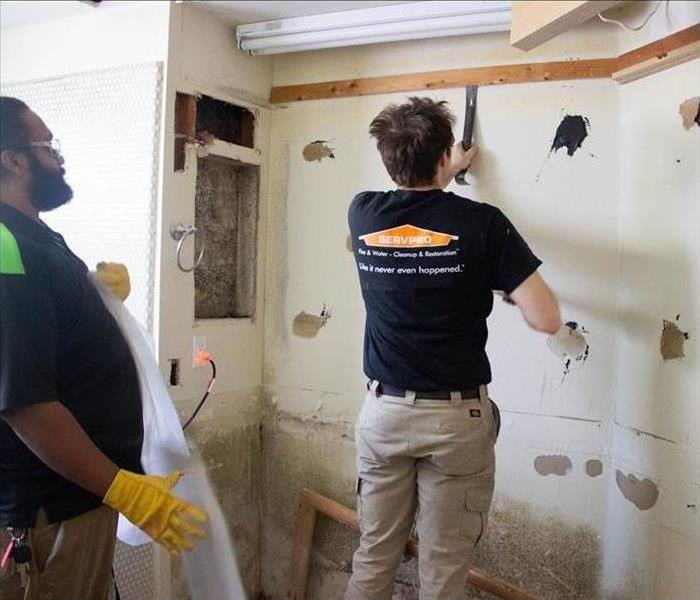 Disaster restoration experts in Lake Murray, CA.
Disaster restoration experts in Lake Murray, CA.
Four Ways SERVPRO Helps Expedite Insurance Claims
In the aftermath of a commercial disaster, your company in Lake Murray, CA, is looking for solutions. This includes a fast cleanup and restoration, as well as efficient handling of insurance claims with an established process for claim services. This ensures your insurance company gets the documentation it needs to fully understand damage estimates and repair costs. Through several actions, a professional damage mitigation team makes sure claims are processed quickly and accurately.
1. Digital Documentation
Handwritten information from multiple contractors will slow down the settlement of claims. With SERVPRO, a preferred vendor for many U.S. insurance companies, the information will be passed onto the right department or person in an easy-to-read and accessible digital format. This will include digital photos to clarify services.
2. One Contractor
While you can deal with multiple companies to clean up and repair storm, water, or fire damage, that is seldom the best path. You could be dealing with different claim services that use unique methods, making things more laborious on your end. Dealing with a single, reputable restoration company streamlines the entire process, from beginning to end.
3. A Fast Emergency Response
It helps when restoration services begin immediately after a disaster. This leads to a quicker recovery and it reduces costs and damages. It will also result in fewer layers of documentation and paperwork for the insurance adjuster.
4. A Dedicated Team
Some companies place the onus of insurance paperwork in the hands of inexperienced workers. For best results, a project manager should handle all communications between the insurance company and the client. This eliminates confusion and the need for constant clarification on important matters. This approach also makes sure insurance details do not get lost or take a back seat to other issues.
A proven process for claim services makes sure your company receives the reimbursements it deserves. It also helps insurance workers meet the expectations of their clients.
Understanding Category Three Water Damage
5/25/2022 (Permalink)
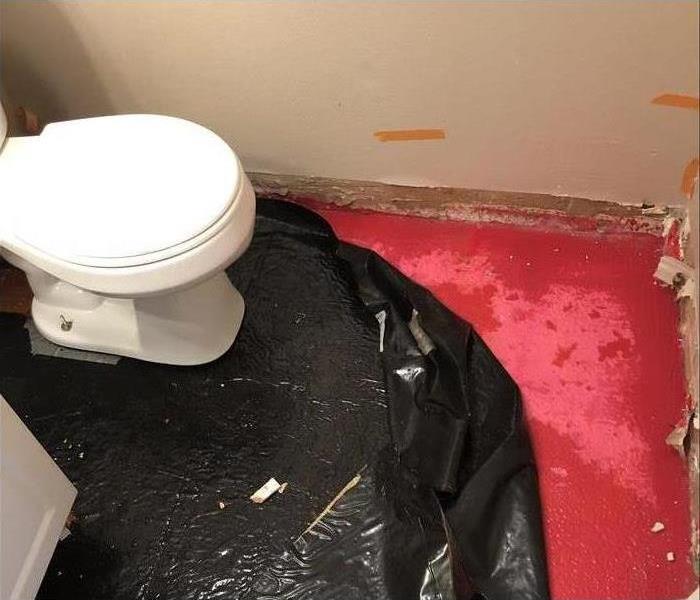 Cleaning up water from the third category is best left to the experts.
Cleaning up water from the third category is best left to the experts.
Water damage to your College East, CA, home is classified into three categories. If this is the first time you've experienced such damage at your residence, you may have heard terms like black water and gray water but are unsure what they mean.
Water Damage Categories
The three categories of water damage are:
Category 1: This category includes water that is considered clean because it does not have contaminants. Examples of category one water damage are a leaking water supply line or an overflowing sink.
Category 2: This water classification is also known as gray water. Examples are water from sump pumps or washing machines.
Category 3: Also known as black water, this category includes storm surge, sewage water, seawater, standing water and ground surface water. Gray water can enter this category if it remains stagnant.
Sewage Cleanup
Cleaning up water from the third category is best left to the experts. A professional remediation company can remove this type of water from your home and ensure that the job is done safely. Porous materials such as drywall, carpet and wood can absorb water fast. Professional technicians have the knowledge and equipment needed to dry out the water as quickly as possible. They can also repair damage and replace materials where necessary, leaving you with a clean, dry home.
A remediation company sends technicians to your house to assess the situation and explain the level of damage to you. They can help you stop the source of the problem if it is ongoing. Technicians then use extraction equipment and industrial dryers to remove water. Once the area is dry, they implement special equipment to sanitize and deodorize your home.
If you have black water damage in your College East, CA, home, it's a good idea to call a professional to help with cleanup. It's the safest and easiest way to repair the damage and get back to normal quickly.
The Challenge of Fixing Water Damage in Your Home
5/18/2022 (Permalink)
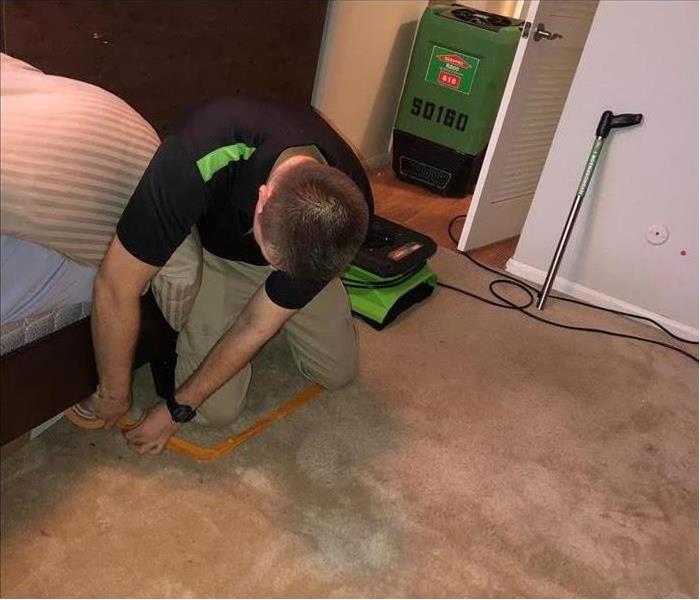 Water damage in a home in College West, CA.
Water damage in a home in College West, CA.
The Problem with Water Damage in Your Home
Your home in College West, CA, has a long list of items you probably would not want to see drenched with water. This makes unwanted water in the home a decidedly unpleasant event. Of course, these things do happen, so it is best to take appropriate action and make the best of things. If the situation involves a large degree of clean water or even a small amount of dirty water, calling for the services of a water damage mitigation franchise should be one of your first actions. A trained team can help you meet a host of challenges
Dealing With a Broken Pipe
When a pipe burst, hundreds if not thousands of gallons of water are likely to spread into your home. This water could drench furniture, clothes, and other personal items, even including paintings, paperwork and fabrics. The solution is not to throw out everything, as that could get expensive. Plus, with the right equipment, many items could be saved. After water in a home disaster, experienced technicians will use advanced techniques to restore items:
- Dry cleaning
- Immersive cleaning
- Abrasive cleaning
- Off-site cleaning and restoration
By using the right techniques for specified items, damage can be minimized. In some scenarios, family heirlooms and other valuable personal items can be restored to excellent condition. While most people do not have the skill and equipment to restore items, a professional franchise uses the best practices of the cleaning and restoration industry.
Recovering From a Water Spill
With water damage, a job that is not done perfectly could lead to additional heartaches. Insufficient drying could lead to mold growth down the road. Improper cleaning could lead to unpleasant smells that permeate your house. For these reasons, it is important to monitor the situation after a water spill.
A water-in-home situation presents many challenges to the cleanliness of your home. Taking the appropriate steps will allow you to move on with few if any worries.
Why Fire Damage Often Includes Water Damage
5/10/2022 (Permalink)
Any unexpected damage to your commercial building in Grantville, CA, is a setback, and fire damage is one of the worst disasters that can happen to a company. Not only can it disrupt your business operations and destroy company records, but it is also a notoriously difficult cleanup job. Fortunately, a full-service fire restoration company can arrive at your property soon after the fire and begin the process.
The Initial Stages of the Cleanup
After a fire, a building can be an unstable place full of hazards for employees. The first stage is to secure the building from additional harm and promote safety for everyone. This is typically done with urgency through several actions:
- A quick inspection of the property
- A board up and tarp coverage if necessary
- A cordoning off of dangerous zones
Once this is accomplished, the workers will perform an additional inspection. The focus at this point will be the development of an orderly and efficient restoration plan.
The Stage That Deals With Water Damage
In any significant fire scenario, fire fighting crews or company sprinkler systems have been utilized to douse the flames. This leads to issues of water in the building, sometimes enough to cause damage to structures, electrical equipment, records and other items. While a sprinkler system is targeted and might not release a lot of water, a fire hose can release hundreds of gallons of water in a short time, demanding attention.
The End Stage of a Cleanup
The next stage deals with cleaning up soot and smoke damage and restoring or replacing damaged items. This can happen fairly quickly in a minor fire, or it can take several days in a larger business fire. The emphasis will be on restoring your working operations as soon as possible.
Fire damage often must deal with multiple ancillary problems. Professional help often leads to the quickest possible recovery.
4 Essential Things To Do After Smelling Natural Gas in Your Home
4/22/2022 (Permalink)
What To Do After Smelling Natural Gas In Your Home
If you begin to smell an odor similar to rotten eggs or sulfur in your Allied Gardens, CA, home, you may be experiencing a gas leak. This could lead to a fire or an explosion. In this event, it's vital that you take immediate action. So, here are four essential things to do after smelling natural gas in your home.
1. Avoid Electrical Charges
Any use of electricity should be avoided at all costs. If you do use something electrical, whatever amount of gas is present could spark and create an explosion. These are some things to avoid:
- Lights
- Appliances (dishwashers, clothes dryers, etc.)
- Plugs
2. Look at the Stove
The last thing you want is to have a big scare over nothing. Therefore, it's important to take a look at your stove and make sure it's not on. If it is, you may not be in danger of a gas fire at all. However, you should still stay safe and ensure that everything's okay before returning to normal.
3. Create Ventilation
If you aren't in immediate danger of a gas explosion, take the time to create ventilation. You can do this by opening every door and window possible. However, you'll want to avoid turning on electrical fans. By creating ventilation, you may be able to get some of the gas out of your home.
4. Leave Your Home
As soon as you can, it's vital that you leave your home. This is hard but necessary. If the worst happens and a gas fire occurs, you'll want to be far away from it. Once you're at least across the street, you can call 9-1-1 and locate a fire restoration service.
Smelling gas in your home can be a daunting experience. Regrettably, you can't spend too much time gathering yourself. Assess the potential of a gas fire and get to safety as soon as possible. Even if this precaution is unnecessary, it's still worth taking.
3 Advantages of Using Professional Storm Services
4/13/2022 (Permalink)
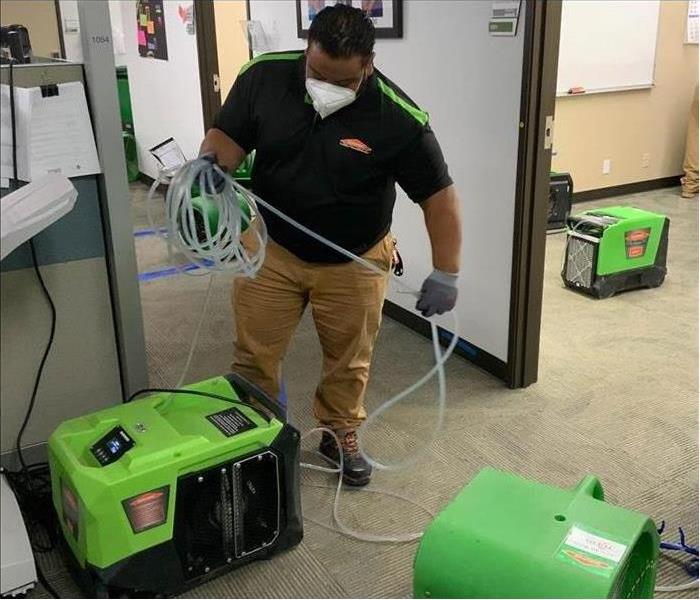 Water damage in Del Cerro, CA.
Water damage in Del Cerro, CA.
Three Reasons to Hire a Professional Storm Service
Hurricanes, typhoons, heavy gusts, tornadoes, snowstorms, flooding and other weather-related disasters in Del Cerro, CA, have the potential to cause severe structural damage and create big messes. The National Oceanic and Atmospheric Administration, or NOAA, reports that between 1980 and 2020, the U.S. has experienced 285 such incidents where costs hit or exceeded $1 billion. The combined total expense of storm restoration, storm response and repairs for these events is over $1.875 trillion.
Insurance companies provide much of the funds required for fixing flood damage and other harm done to commercial properties. It is advantageous for them to employ the services of a professional storm company for multiple reasons.
1. Faster Response
Situations needing storm restoration generally worsen as time passes. Water damage especially tends to spread, promoting mold growth and rendering certain items irreparable as they become saturated. Drywall, carpeting and other building materials often have to be thrown away in the wake of a deluge but may sometimes be preserved if swift action is taken. A faster response results in numerous benefits, including:
- More possessions can be salvaged
- The advance of damage is slowed or halted
- Cleaning costs are lower
- Restoration costs are lower
2. Quality Service
Professionals are trained to provide quality aid. They are capable of identifying existing issues, assessing the extent of the damage and prioritizing what needs to be done. They know the best methods for drying, sanitization and restoration.
3. Resource Availability
Storm response services also possess the necessary resources to get the task done. There are teams of experienced experts ready to mobilize at any given moment. They also have the tools needed to effectively perform their tasks readily at hand.
Having a storm restoration business on call also speeds up the claims and restoration process. Professional teams can help owners create itemized lists of needed replacements and repairs and evaluate and record damage. They also mitigate the impact of disasters.
3 Differences Between Flood Damage and Other Water Damage
4/8/2022 (Permalink)
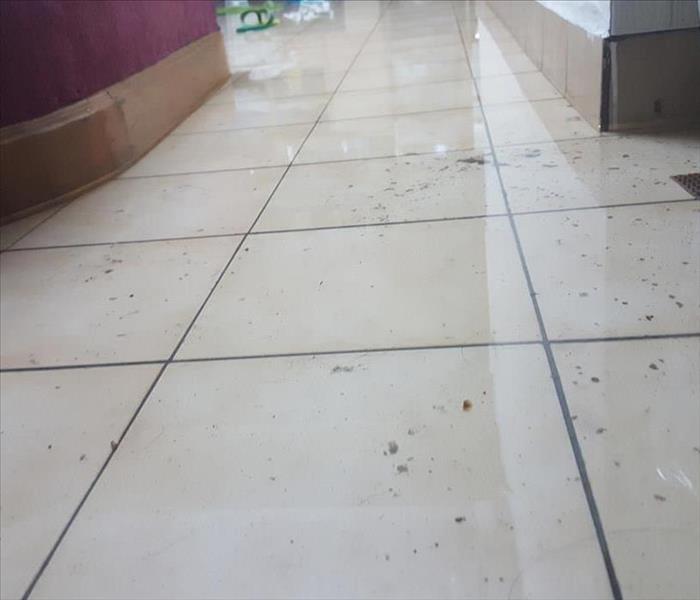 Sewage water fall under the third category.
Sewage water fall under the third category.
3 Key Distinctions Between Flood and Other Water Damage
If there is a serious storm in San Carlos, CA, then you can expect that your commercial building will be affected on some level. Water can come from a variety of sources, and not all of these will cause the same level of trouble. Damage from a flood, for example, differs in the following ways.
1. Contamination Levels
There are three categories of water that you could find yourself dealing with when water damage occurs. Each of these has a different level of contamination. Category 1 is clean; category 2, or gray water, is moderately contaminated; and category 3, or black water, is highly contaminated. Because it picks up debris, sewage and other contaminants from the ground, flood water falls under the third category.
2. Cleanup and Repairs
Because of the high level of contamination, it contains, category 3 water needs to be treated differently than the rest. Blackwater should be removed by a professional restoration service that has the necessary equipment and training to handle this type of emergency. Everything that has been affected will need to be thoroughly cleaned and sanitized. Absorbent materials that cannot be cleaned should be replaced.
3. Insurance Coverage
Another important difference between this and other kinds of water damage is insurance coverage. In many cases, your basic insurance does not cover floods. You will need to purchase an additional policy to ensure your business is prepared for this particular situation. If you are in an area where disasters of this nature occur often, you may be required to have additional coverage.
Although it is important to have any kind of water damage addressed as quickly as possible, there are some additional difficulties that can come with a storm. If your business is located in an area where this is likely, you should take precautions to ensure you are prepared for damage involving category 3 water. To keep your building safe, always have restoration of this kind done by a professional.
3 Ways To Prevent Burst Pipes on a Commercial Property
3/31/2022 (Permalink)
Three Ways to Avoid Commercial Property Pipe Bursts
Burst pipes can be devastating for property owners in Santee, CA. Causes for bursting pipes range and can include:
- Increased water pressure
- Loose pipes
- Winter Storms
You can prevent your property's pipes from bursting by taking preventative measures before a winter storm and repairing damages to plumbing systems as soon as they become noticeable. Here are 3 ways to prevent burst pipes on a commercial property.
1. Insulate Your Property's Pipes
Insulation prevents the water inside of pipes from freezing. When water freezes inside a building's plumbing system, the water pressure increases causing pipes to burst under the added stress. To prevent this, contact a plumber to properly insulate the pipes. You can also take action when a storm is approaching by letting your water run at a drip and opening cabinet doors to allow warmer air around pipes. Storm damage is a common cause of leaks and pipe bursts but can be prevented with preparation.
2. Replace Old Plumbing Systems
Outdated plumbing systems do not have rust-resistant materials and are prone to tears. The materials used to make older plumbing systems include cast iron pipes, which become eroded with frequent water use and changing weather conditions. When a winter storm hits, these plumbing materials become more vulnerable to bursts. Update your plumbing system to ensure its best functionality.
3. Inspect Your Plumbing System Regularly
Be diligent with your plumbing system catching tears, worn joints and leaks before they surprise you. Keeping your system up to date will prevent leaks from worn pipes and protect your building from pipe bursts during inclement weather. Leaks and burst pipes are preventable with proper maintenance and insulation.
If you have experienced a pipe break due to a winter storm, contact a local water damage restoration service to help clean your property. A professional service will also help to dehumidify your property and restore it back to normal.
Tips To Protect Your Business From Disaster
3/31/2022 (Permalink)
Disaster Preparedness Tips for Your Business
When severe weather strikes, you are undoubtedly worried about protecting your business. A tornado, hurricane or severe downpour can cause flooding and physical damage to your building and affect your ability to sustain your regular business practices. Designing a custom emergency response plan can be invaluable if your San Carlos, CA, business experiences a serious disruption.
Your Business Continuity Plan
Having a plan that addresses all types of potential damage is essential to your company’s risk-management strategy. These steps may help you create a solid plan that protects you.
Identify the risks particular to your business, such as a nearby flood plain, coastal hurricane vulnerability or a basement that often floods.
Assess the potential impacts on your staff, your property and your daily operations for each risk category.
Outline preventive measures that address each risk area, such as flood-prevention maintenance or fire-safety planning.
Formulate the specific steps to be followed by you and your staff in case of an emergency.
Regularly review, update and test your business continuity plan with live drills.
A well-designed plan can give you and your workforce a better chance of working together to prevent damage and minimize property loss.
Emergency Preparedness Tips
As part of your plan, you may want to keep an emergency kit on site. The kit might include items such as water, flashlights, extra batteries, protein bars, and a medical first-aid kit. It is also important to make sure you have fire extinguishers placed throughout your building. Many businesses find that a local fire department or disaster remediation service will happily offer your staff trainings in fire extinguisher operation, evacuation procedures and other preventive measures. For more detailed information about continuity planning and disaster preparedness, you can consult government resources like Health and Human Services or Federal Emergency Management Agency.
This brief overview may help you formulate a business continuity plan that can both protect your business and your peace of mind. Disaster preparedness may not be at the top of your list, but it can make a big difference when your property and your bottom line are threatened by an emergency.
Exploring the Different Types of Fire Extinguishers
3/31/2022 (Permalink)
Types of Fire Extinguishers
Responsible homeownership means having an insurance policy that covers damages to your house and its contents due to a fire. Usually, entities with a financial interest in your house, such as a mortgage company will require borrowers to carry this coverage, including properties in Del Cerro, CA. Being a good homeowner also means staying on top of fire preparedness. This includes being careful about the use of open flames on your property. It also means having the means to put out or control a blaze, such as having a sprinkler system that operates when a home fire is detected. Keeping a fire extinguisher in various rooms is also part of a complete plan, but not all types are created equal. Here’s what you should know.
Taking a Closer Look at Extinguishers
Extinguishers come in three different classifications based on effectiveness against a type of blaze. Class A refers to fires caused by trash, wood and paper. Class B includes fires started by flammable liquids, while class C is for blazes caused by live electricity. Each fire extinguisher has a label with the classification and a number that corresponds to the device’s effectiveness. Extinguishers come in different sizes that correspond to usage:
- Stove-top: Ideal for mounting above a range or oven
- 2-pound: Good for use in a vehicle
5-pound: Easily accessible in a kitchen or utility room
- 10-pound: Best for garages or workshops where a blaze can rapidly spread
Taking Care
It’s important to make sure that these fire defense items are stored properly. Should a home fire occur, you don’t want to learn that the extinguisher is not where you need it or has lost pressure. Extinguishers should be replaced or refilled after a single-use.
While you never hope to experience a home fire, you should be knowledgeable of what to do in advance. Professional fire remediation experts can help restore your home to pre-damage conditions, but proper use of a fire extinguisher can reduce overall damage. It can minimize the time it takes to repair your home.
How Do Experts Clean Up Sewer Damage?
2/18/2022 (Permalink)
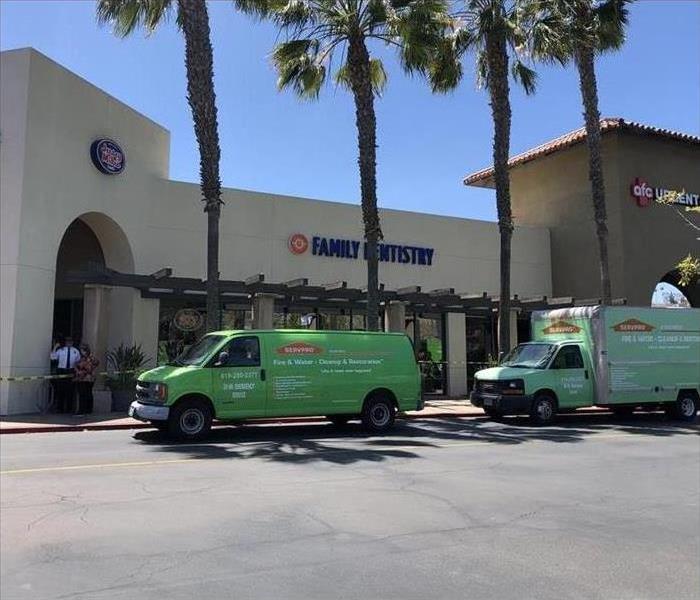 When you find sewage in your commercial property, be sure to call the trained experts at SERVPRO for cleanup and restoration services.
When you find sewage in your commercial property, be sure to call the trained experts at SERVPRO for cleanup and restoration services.
How Do Professionals Repair Sewer Damage?
Water leaks in a commercial property can be either uncontaminated, such as a leak that originates from a broken supply line, or contaminated gray from flooded toilets or a sewer backup. Sewer cleanup involves contaminated water that may contain potentially dangerous substances such as chemicals or microbes and should be performed by certified professionals. Cleanup and restoration experts will follow several steps in commercial properties that have recently experienced a leak involving contaminated water.
1. Contain the leak and remove water and sewage: Cleanup experts will remove excess water and any traces of solid waste from the affected area to prevent water and sewage damage from spreading or worsening.
2. Clean and disinfect the affected area: Professionals use industrial-grade sewer cleanup equipment and may depend on pump sprayers or foggers to eliminate the presence of dangerous bacteria.
3. Dispose of ruined contents: Any materials that cannot be cleaned and decontaminated should be removed as soon as possible and replaced.
4. Drying and decontamination: Experts will thoroughly dry the affected area and decontaminate items that are capable of being salvaged.
5. Restore the area and contents: Restore the cleaned, disinfected, and dried area and contents to pre-damage conditions.
As soon as a commercial property experiences a sewage leak, you should call a plumber and address the source of the problem. Once the leak has stopped, contact a company that specializes in cleaning up sewer damage in commercial properties.
You can depend on the expertise of a certified sewer cleanup service to ensure that your facility is cleaned, disinfected, and dried in compliance with health and safety standards. If you are dealing with a sewage leak in a commercial property located in San Diego, CA, a sewer damage restoration company can help you ensure that your commercial structure is clean, dry, free of mold, and safe for tenants and visitors.
What To Look For When Choosing a Restoration Company
2/18/2022 (Permalink)
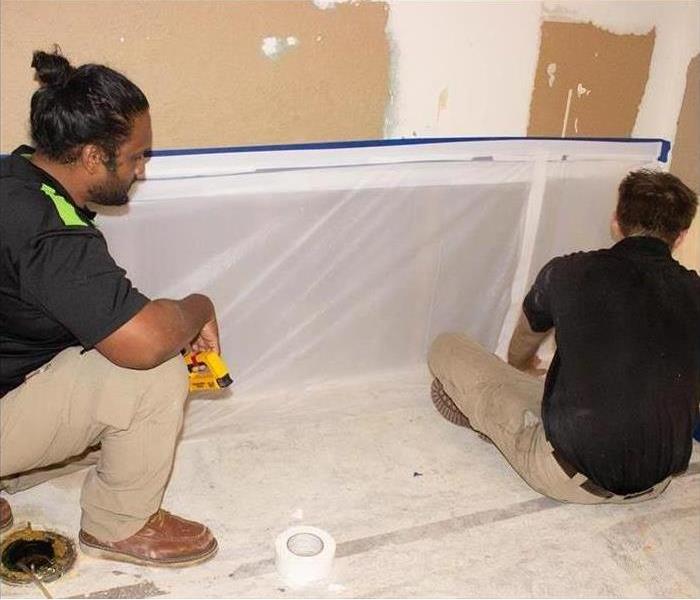 The SERVPRO San Diego East team is setting up for containment after a massive water leak. If your home suffers water damage, call us!
The SERVPRO San Diego East team is setting up for containment after a massive water leak. If your home suffers water damage, call us!
When It Comes To Choosing A Restoration Company, There Are A Few Things To Keep In Mind.
When a homeowner’s house in Santee, CA becomes damaged as a result of a flood, storm or fire, choosing a company to assist in the restoration process can be difficult. There are several factors to consider that can help homeowners find a company that’s Faster to Any Size Disaster.
1. Experience
After a disaster, damage to a home can be extensive and multifaceted. For example, water damage can also result in mold growth, and fires can make an area more prone to flooding. Though some companies specialize in certain types of disaster responses, it’s generally wise to choose a company that knows how to handle a myriad of issues. An experienced restoration company can also assist homeowners with their insurance claim and can answer questions.
2. A Quick Response
After a home becomes damaged, it’s often important for the restoration process to begin as quickly as possible. The longer it takes for restoration to begin, the more likely it is that the amount of damage will increase, meaning the cost and time it will take to complete restoration can drastically increase. A restoration company that is locally owned will respond Faster to Any Size Disaster, whereas a company that is not local will be more likely to have a slower response.
3. Access to the Right Tools and Equipment
When it comes to restoring a home, it’s often important that a restoration company can quickly access the tools and equipment necessary. When specialized equipment is needed to restore a home, waiting to equipment to arrive can bring the process to a grinding halt. However, a local business that is part of a franchise will have access to a myriad of helpful equipment and can also get the equipment to damaged homes in a timely manner.
Experience, response time and access to the best tools and equipment are important factors to consider when choosing a restoration company. Ultimately, a restoration company that is Faster to Any Size Disaster can improve the process for everyone involved.
Managine Smoke Detector Power
2/18/2022 (Permalink)
Control The Smoke Detector's Power
Keep your home in San Carlos, CA, free from fire hazards by maintaining and monitoring your smoke alarm systems. Read on to glean a few tips related to these important home devices.
1. Source
Know the power source of your chosen model of smoke detector. Some models can be wired directly to the wall, and thus will run on your home’s electrical system. Others use replaceable 9-volt batteries or non-replaceable lithium ion power sources. Some detectors may combine both of these methods as a backup in case of home power failure. Regardless, you should test the units each month to ensure that they are fully functional. If the device is blinking or beeping, this may be an indicator that the unit has insufficient power.
2. Age
Smoke detectors are not built to last forever. Both ionization and photoelectric alarm types suffer from reduced effectiveness as they age. A typical smoke alarm will only last for about ten years. Luckily, they are inexpensive to replace, typically costing less than $20. A wide selection of models is available at your local hardware or department store. Examine the date of manufacture on the back of the unit to determine an appropriate time to rotate out your set of detectors.
3. Safety
By maintaining your smoke detection systems, you can prevent fire damage and loss of life. Many residential fires occur while most people are asleep, so it is extremely important to have an automated system in place to alert friends and family to fire hazards. The risk of health and property damage from fire goes down substantially when smoke detectors are well-distributed throughout the house, especially if they are connected to activate one another when any single unit detects smoke.
By taking care of your smoke alarm setup, you can prevent physical harm to your occupants and damage to your home that could require costly professional fire restoration.
Protect Your Home From Water Damage While You Are on Vacation
1/29/2022 (Permalink)
The second most common cause for claims made against homeowners insurance in San Diego, CA, is water damage, causing damage in the millions of dollars every year. You may not need to do a water pipe repair, but you can help prevent such a disaster from happening in your home while you are away on vacation by taking stock of a few things and performing a few preventive measures.
Steps To Prevent Leaks While on Vacation
•Check all exposed pipes, including under sinks, for leaks and wetness
•Look at connection tubes and supply lines on washing machines, dishwasher, ice maker and so on
•Make sure any exposed pipes are insulated or have heat tape to prevent a pipe burst
•If you plan to turn the heat down while you are away, leave it high enough to keep pipes warm. Leave cabinet doors open under sinks.
After relaxing on vacation, the last thing you want to come home to is a frozen pipe or leak of some kind that has been causing damage since you left. Wet carpets and flooring left to sit can also damage subflooring and can grow bacteria and mold. Broken pipes inside of walls can produce enough water to disintegrate sheetrock, warp and weaken studs, and ruin electrical wiring. Even furnishings and other belongings can suffer water damage if left to sit in wet or damp circumstances.
Water pipe repair can be expensive in San Diego, CA, as can reclamation of your home and belongings. You may feel helpless and not know where to start. Get some help with your water damage repair process from professionals who understand what is needed and have the proper equipment for water removal and dehumidification. They can help check all sources of water in your home and make sure any necessary water pipe repair is done.
Fortunately, much of this damage can be prevented simply by taking the precautions listed above. You can take your next vacation worry-free and come home relaxed to a home where everything is intact.
3 Things To Avoid After a Flood
1/23/2022 (Permalink)
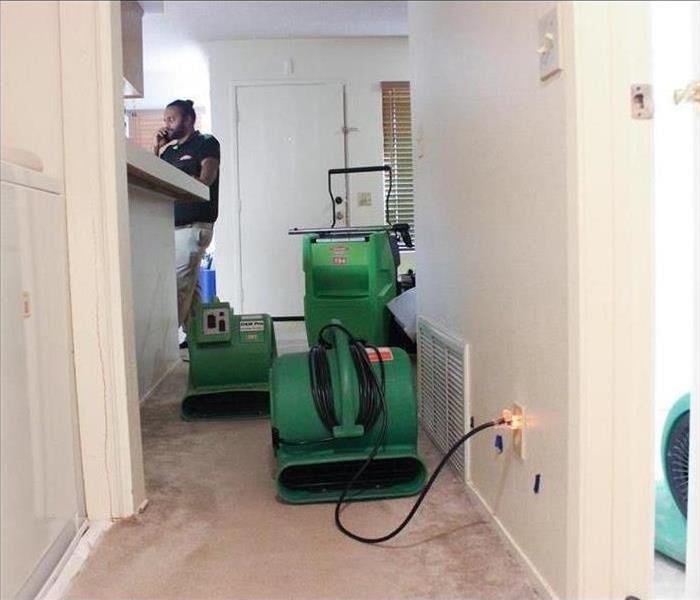 Storm remediation in Lake Murray, CA.
Storm remediation in Lake Murray, CA.
How To Handle Flood Damage
When storms send flood water into your Lake Murray, CA, home, you don't always know what to do. When is it safe to return to your house? Can you start the cleanup on your own? How you handle a flood will depend on the severity of the damage. It can be helpful to call about storm damage services right after the storm has left your area. You should also try to avoid doing the following:
1. Walking Into Standing Water
Did you know that 6 inches of moving water can cause you to lose your footing? Because even shallow waters can be dangerous, you should avoid walking into any standing water. Your flooded home may be full of stagnant water, but you should still avoid going into it. If the electricity is on, the water could be charged. Storm water could contain dangerous contaminants, too.
2. Waiting To Schedule a Cleanup
Do you want to try to tackle the water damage on your own? Unless you know how to effectively remove flooding and humidity from your house, you should turn to a professional. The sooner you can schedule your cleanup, the better it will be for your home. If you wait too long, you may have increased mold growth in your space.
3. Returning to Your Home Too Soon
While you want your life to return to normal, you need to make sure the flood water is completely gone before you return. Going home too soon can make it harder for the cleanup crew to properly remove excess humidity. The cleanup may require building materials to be replaced, which can leave your home dusty. If you wait until the entire process is finished, you can return to a more normal life right when you move back in.
Storm flood water may cause you to leave your home until the damage can be fixed. Taking the wrong steps after this type of flood can make the restoration process harder than it has to be, so remember what not to do.
What Documents Do You Need for a Commercial Fire Damage Claim?
1/18/2022 (Permalink)
Fire Claim Process
Experiencing a fire at your office building in College East, CA, can be taxing on you and your business. Filing an insurance claim after the incident may also seem like a daunting task without the right guidance. However, you can help your fire claim process smoothly by keeping documentation of the following items.
1. Evidence of Damage
Having proof of the fire damage is crucial when filing a claim. If it is possible, request a report of the fire from the police or fire department. Make sure that you have photographs of all the damaged areas and items. It is also handy to have pictures of the property before the damage occurred so that the insurance company can make a comparison of the property before and after the fire. Fire restoration service personnel may also assist in photographing the damage before cleaning up and restoring the space.
2. Temporary Repairs
If you must wait for an insurance adjuster to inspect the damage first before processing your claim, you should prevent the property from getting further damaged in the meantime. This may involve storing equipment in a safer area, boarding up windows and putting tarp over exposed areas. Remember to keep the receipts of any purchases made for these temporary repairs, as you may get reimbursed for them through your fire claim.
3. Business Value and Income
Submit copies of any records that show the value of your property, inventory and equipment, such as receipts and financial statements. For business income coverage claims, include all financial documents that prove your projected net income before and after the fire. The insurer will use the information to determine whether there was a loss of income due to fire damage and may compensate you accordingly.
Having insurance can help your business recover faster after a fire. When submitting a fire claim, the more documentation you have, the better your chances are at getting a fair amount of coverage for your repairs or income loss.
 Prepare your San Diego home for winter by securing your roof, gutters, and windows against rain and wind.
Prepare your San Diego home for winter by securing your roof, gutters, and windows against rain and wind.






 24/7 Emergency Service
24/7 Emergency Service

























